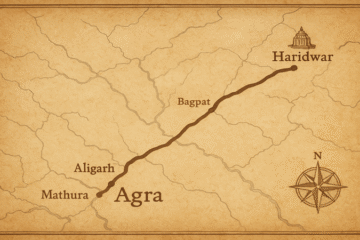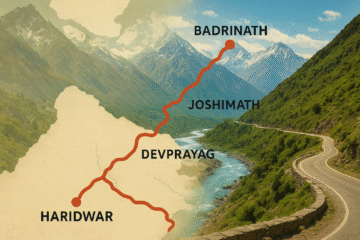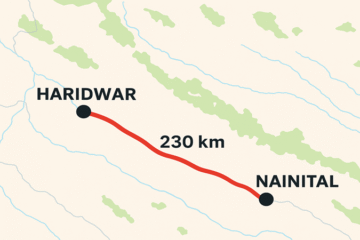Table of Contents
India, a land steeped in history and vibrant culture, boasts an unparalleled collection of architectural marvels that stand as testaments to its glorious past. From ancient rock-cut caves to sprawling Mughal palaces and colonial-era landmarks, these structures narrate tales of empires, art, devotion, and resilience. Exploring the top 50 monuments of India is not just a sightseeing tour; it’s a profound journey through millennia of human endeavor and artistic expression. These sites, many of which are UNESCO World Heritage Sites, draw millions of visitors annually, offering a captivating glimpse into the nation’s diverse heritage.
Let’s embark on this magnificent exploration of India’s most iconic historical treasures.

1. Taj Mahal, Agra, Uttar Pradesh
The Taj Mahal in Agra, Uttar Pradesh, stands as one of the most celebrated and admired monuments of India. Renowned globally for its breathtaking beauty, this white marble masterpiece was commissioned by the Mughal Emperor Shah Jahan in 1632 in memory of his beloved wife Mumtaz Mahal. It took over 20 years and around 20,000 artisans to complete, making it not only a symbol of eternal love but also a testament to the architectural brilliance of the Mughal era.
As one of the finest examples of Mughal architecture, the Taj Mahal seamlessly blends Persian, Islamic, and Indian styles. Its grand dome, symmetrical minarets, intricate inlay work with semi-precious stones, and verses from the Quran inscribed in elegant calligraphy reflect exquisite craftsmanship. Set against the serene backdrop of the Yamuna River, the monument is surrounded by lush Mughal gardens designed in the Charbagh layout, enhancing its tranquil and majestic presence.
Recognized as a UNESCO World Heritage Site in 1983, the Taj Mahal is often referred to as the “crown jewel” of monuments of India. It attracts millions of tourists every year from across the globe, enchanted by its romantic history and stunning architecture. Whether bathed in the golden light of sunrise or glowing under the moonlight, the Taj Mahal offers a unique visual experience that changes with every hour.
As one of the top monuments of India, the Taj Mahal not only represents the artistic peak of the Mughal dynasty but also serves as a symbol of India’s rich cultural and historical heritage. A visit to this timeless monument is an essential part of any journey through India, offering a deep connection to the country’s past, beauty, and enduring legacy.

2. Red Fort (Lal Qila), Delhi
The Red Fort, also known as Lal Qila, is one of the most iconic and historically significant monuments of India. Located in the heart of Old Delhi, this massive red sandstone fort was built by the Mughal Emperor Shah Jahan in 1648 when he moved his capital from Agra to Delhi. Serving as the main residence of the Mughal emperors for nearly 200 years, the Red Fort stands as a powerful symbol of India’s royal and colonial past.
Spread over 254 acres, the fort is enclosed by massive red sandstone walls that stretch over two kilometers. The architecture of the Red Fort is a splendid blend of Persian, Timurid, and Indian styles. It houses several impressive structures such as the Diwan-i-Aam (Hall of Public Audience), Diwan-i-Khas (Hall of Private Audience), Rang Mahal (Palace of Colors), and the stunning Moti Masjid (Pearl Mosque), each adorned with intricate carvings and delicate marble inlay work.
A UNESCO World Heritage Site since 2007, the Red Fort is not only an architectural marvel but also a symbol of India’s sovereignty. Every year on Independence Day, the Prime Minister hoists the national flag from its ramparts, addressing the nation from its historic Lahori Gate.
As one of the most prominent monuments of India, the Red Fort represents the grandeur of the Mughal Empire and the resilience of the Indian spirit. It draws visitors from around the world who come to witness its magnificence and explore its museums, gardens, and historical corridors.
Whether admired for its majestic architecture or revered for its historical significance, the Red Fort remains a timeless treasure in India’s vast heritage, reflecting the country’s glorious past and vibrant culture.
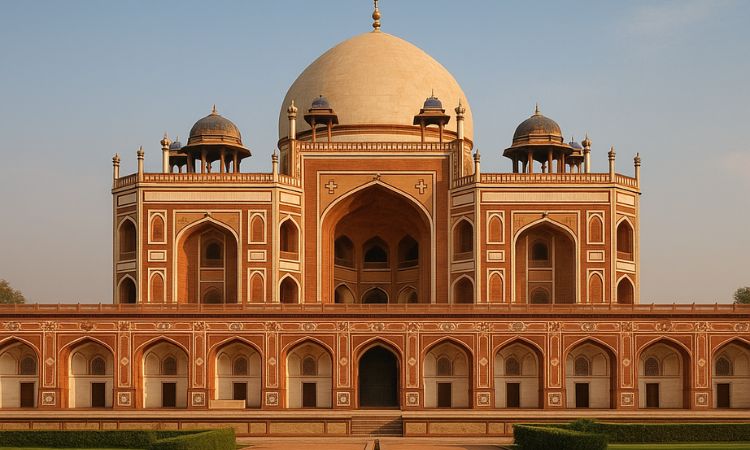
3. Humayun's Tomb, Delhi
Humayun’s Tomb, located in Delhi, is one of the most magnificent monuments of India and a fine example of early Mughal architecture. Commissioned in 1565 by Empress Bega Begum, the wife of Mughal Emperor Humayun, the tomb was designed by the Persian architect Mirak Mirza Ghiyas. It was completed in 1572 and holds the distinction of being the first garden tomb in the Indian subcontinent.
Built with red sandstone and white marble, Humayun’s Tomb reflects Persian and Mughal design sensibilities. The grand structure is set in the middle of a vast Charbagh-style garden, divided into quadrants by water channels and walkways. The central dome rises majestically above the square structure, surrounded by intricate arches, lattice screens (jalis), and decorative tile work. The symmetrical layout, peaceful gardens, and architectural elegance make it a masterpiece of Indo-Islamic art.
Recognized as a UNESCO World Heritage Site in 1993, Humayun’s Tomb not only inspired the construction of later Mughal monuments, including the Taj Mahal, but also marks a turning point in Indian architecture. The complex also houses several smaller monuments, including the tomb of Isa Khan, an Afghan noble, which predates the main structure.
Today, Humayun’s Tomb is one of Delhi’s most visited attractions, drawing tourists, historians, and architecture enthusiasts from around the world. It stands as a proud symbol of India’s rich historical and cultural legacy.
As one of the most significant monuments of India, Humayun’s Tomb offers a glimpse into the opulence and vision of the Mughal dynasty. Its tranquil setting, artistic detailing, and historical value make it a must-visit site for anyone exploring India’s heritage.
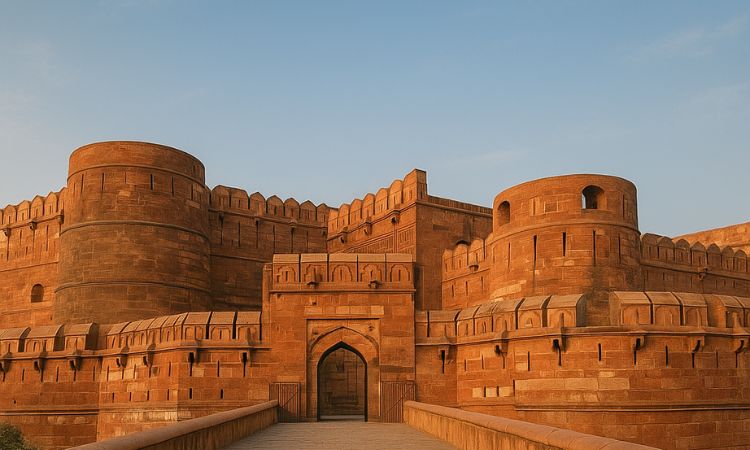
4. Agra Fort, Agra, Uttar Pradesh
Agra Fort, located in Agra, Uttar Pradesh, is one of the most prominent and historically rich monuments of India. Also known as the Red Fort of Agra, it served as the main residence of the Mughal emperors before the capital shifted to Delhi. Built primarily by Emperor Akbar in 1565 and later modified by Shah Jahan, the fort stands as a symbol of Mughal power, architecture, and grandeur.
Constructed using red sandstone, Agra Fort spans about 94 acres and is surrounded by a massive wall that stretches over 2.5 kilometers. The fort’s semi-circular layout is fortified by imposing bastions and majestic gateways, including the famous Delhi Gate and Amar Singh Gate. Inside, it houses a range of beautiful structures such as the Diwan-i-Aam (Hall of Public Audience), Diwan-i-Khas (Hall of Private Audience), Jahangir’s Palace, Khas Mahal, and the exquisite Musamman Burj, where Shah Jahan is believed to have spent his final days gazing at the Taj Mahal.
Recognized as a UNESCO World Heritage Site, Agra Fort represents a fusion of Islamic and Hindu architectural styles. Its courtyards, marble pavilions, and intricate decorations reflect the artistic brilliance of the Mughal era.
Located just 2.5 kilometers from the Taj Mahal, Agra Fort is not only a historical monument but also a key part of India’s cultural and architectural heritage. It played a vital role in the political history of India and witnessed several significant events during the Mughal reign.
As one of the most celebrated monuments of India, Agra Fort attracts millions of visitors each year. Its royal legacy, architectural excellence, and historical depth make it an essential destination for those exploring the wonders of Mughal India.

5. Fatehpur Sikri, Uttar Pradesh
Fatehpur Sikri, located near Agra in Uttar Pradesh, is one of the most remarkable monuments of India and a stunning example of Mughal architectural excellence. Built in the late 16th century by Emperor Akbar, Fatehpur Sikri served as the Mughal capital for around 14 years before being abandoned due to water scarcity. Despite its short tenure as a political hub, the city remains a shining symbol of Akbar’s vision and grandeur.
Constructed primarily in red sandstone, Fatehpur Sikri is a blend of Persian, Islamic, and Hindu architectural elements. The city is laid out in a precise geometric plan and includes royal palaces, audience halls, mosques, and residential complexes. Notable structures within the complex include Buland Darwaza – the 54-meter-high gateway celebrating Akbar’s victory in Gujarat, Jama Masjid, Diwan-i-Aam, Diwan-i-Khas, Panch Mahal, and Jodha Bai’s Palace. Each of these monuments showcases detailed carvings, jali work, and symmetrical designs that reflect the finesse of Mughal craftsmanship.
Fatehpur Sikri is also famous for Salim Chishti’s Tomb, a revered Sufi saint whose blessing is said to have fulfilled Akbar’s wish for a son. Pilgrims and tourists still visit the tomb, tying threads to its lattice windows as a symbol of their prayers.
Designated as a UNESCO World Heritage Site, Fatehpur Sikri remains a major tourist attraction, drawing visitors from around the world to witness its historic and architectural significance.
As one of the outstanding monuments of India, Fatehpur Sikri tells the story of a glorious but brief era in Indian history. It stands as a testament to Emperor Akbar’s inclusive governance and artistic vision, making it a must-visit for those exploring India’s royal heritage and Mughal legacy.
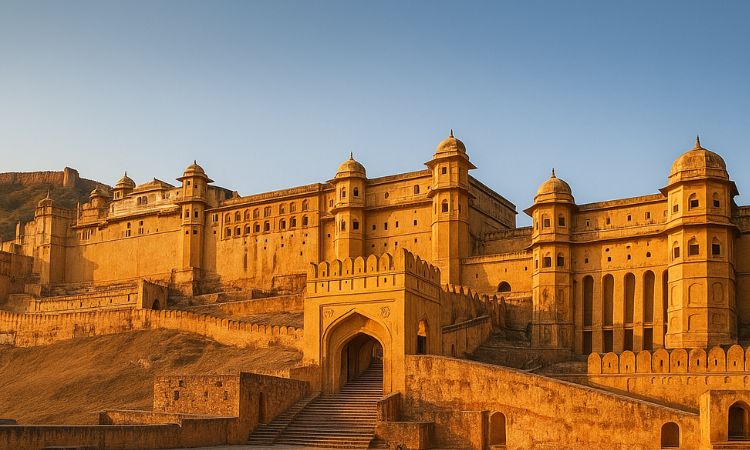
6. Amer Fort (Amber Fort), Jaipur, Rajasthan
Amer Fort, also known as Amber Fort, is one of the most magnificent and historically significant monuments of India, located in Jaipur, Rajasthan. Perched on a hilltop overlooking Maota Lake, this grand fort was built in 1592 by Raja Man Singh I and later expanded by successive rulers of the Kachwaha dynasty. It is a brilliant blend of Rajput and Mughal architectural styles, reflecting the opulence of Rajasthan’s royal past.
Constructed primarily from red sandstone and white marble, Amer Fort is famous for its artistic elements, including intricately carved pillars, mirror work, frescoes, and lattice windows. The fort is divided into several courtyards, each with its unique features. The Ganesh Pol, an ornate gateway, leads to the private palaces of the kings. The Sheesh Mahal (Mirror Palace) is the most celebrated part of the fort, where tiny mirror tiles create a dazzling effect when illuminated.
The fort also includes the Diwan-i-Aam (Hall of Public Audience), Diwan-i-Khas (Hall of Private Audience), Sukh Niwas, and the Zenana (women’s quarters). The sound and light show held in the evenings narrates the fort’s rich history, enhancing the visitor experience.
Recognized as a UNESCO World Heritage Site as part of the Hill Forts of Rajasthan, Amer Fort attracts thousands of tourists daily and is a major highlight of Jaipur’s cultural tourism.
As one of the top monuments of India, Amer Fort stands as a symbol of Rajput valor, royal lifestyle, and architectural brilliance. Its majestic presence, scenic location, and historical richness make it a must-visit destination for travelers exploring the royal heritage of Rajasthan and India’s glorious past.
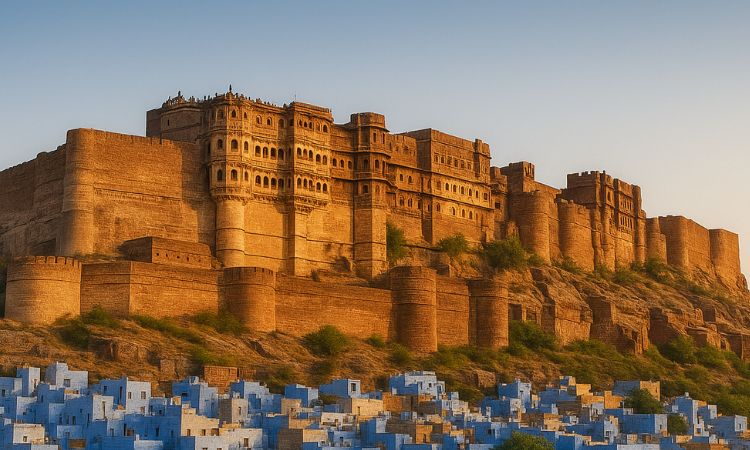
7. Mehrangarh Fort, Jodhpur, Rajasthan
Mehrangarh Fort, located in Jodhpur, Rajasthan, is one of the largest and most impressive monuments of India. Perched on a rocky hill at a height of 410 feet, the fort dominates the skyline of Jodhpur and offers breathtaking views of the “Blue City” below. It was built in 1459 by Rao Jodha, the founder of Jodhpur, and expanded by his successors over several centuries.
Constructed with massive stone walls up to 36 meters high and 21 meters wide, Mehrangarh Fort is a symbol of Rajput strength and architectural brilliance. The entrance to the fort is marked by several imposing gates, including Jayapol, Fattehpol, and Loha Pol, each commemorating significant historical victories. The fort complex includes intricately decorated palaces such as Moti Mahal (Pearl Palace), Phool Mahal (Flower Palace), Sheesh Mahal (Mirror Palace), and Zenana Mahal, all showcasing splendid carvings, colorful murals, and regal furnishings.
Today, Mehrangarh Fort houses a well-curated museum that displays a rich collection of artifacts, including royal costumes, palanquins, weapons, paintings, and musical instruments, giving visitors a glimpse into Rajasthan’s glorious past. The fort also hosts traditional music and cultural performances, especially during the Rajasthan International Folk Festival and the World Sacred Spirit Festival.
Mehrangarh Fort has been a UNESCO Tentative World Heritage Site and is considered a symbol of Jodhpur’s royal legacy and valor. Its grandeur, historical importance, and architectural marvel attract tourists, historians, and photographers from all over the world.
As one of the finest monuments of India, Mehrangarh Fort stands as a timeless representation of Rajput pride, rich culture, and magnificent artistry, making it a must-visit destination in Rajasthan.

8. Hawa Mahal, Jaipur, Rajasthan
Hawa Mahal, or the “Palace of Winds,” is one of the most iconic and architecturally unique monuments of India, located in the heart of Jaipur, Rajasthan. Built in 1799 by Maharaja Sawai Pratap Singh, this five-story palace was designed by Lal Chand Ustad and reflects the rich blend of Rajput and Mughal architectural styles.
Constructed using red and pink sandstone, Hawa Mahal is known for its distinctive façade featuring 953 small jharokhas (windows), intricately carved with latticework. These windows were designed to allow royal women to observe street festivals and daily life without being seen, in line with the strict purdah system of the time. The lattice also allows cool air to circulate through the palace, offering natural ventilation even during Jaipur’s hot summers—hence the name “Palace of Winds.”
Despite its grand appearance, the structure is relatively narrow and more ornamental than residential. Inside, it has ramps instead of stairs and leads to open courtyards and galleries that offer stunning views of the City Palace, Jantar Mantar, and the bustling streets of Jaipur.
Hawa Mahal is a symbol of Jaipur’s rich heritage and is a major tourist attraction. It forms an integral part of the city’s identity and is often used in visual representations of Rajasthan. Its stunning architecture and cultural significance make it a must-visit site for both domestic and international travelers.
As one of the most enchanting monuments of India, Hawa Mahal represents the artistic excellence and royal lifestyle of the Rajput era. With its honeycomb-like design, historical relevance, and architectural grace, Hawa Mahal continues to captivate visitors and stands as a proud emblem of Jaipur’s regal legacy.
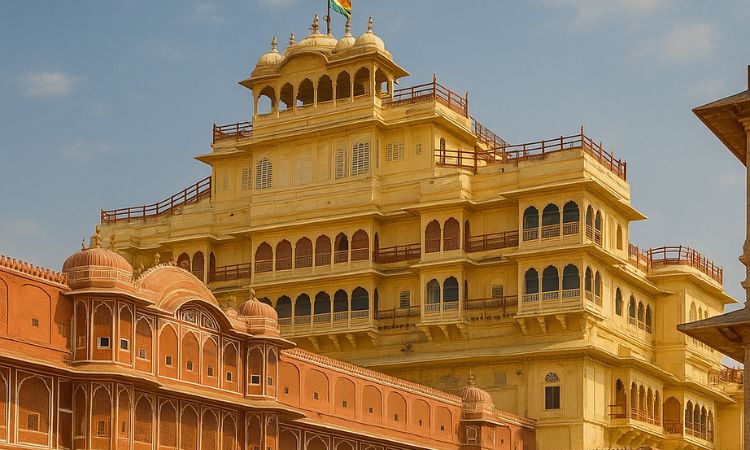
9. City Palace, Jaipur, Rajasthan
City Palace, located in the heart of Jaipur, Rajasthan, is one of the most magnificent and historically significant monuments of India. Built between 1727 and 1732 by Maharaja Sawai Jai Singh II, the founder of Jaipur, the palace complex served as the royal residence and administrative seat of the Maharajas of Jaipur.
The City Palace is a fine blend of Rajput, Mughal, and European architectural styles, showcasing opulent courtyards, grand gateways, marble columns, intricate latticework, and beautifully decorated walls. The complex includes several stunning buildings, courtyards, and museums. Notable structures within the palace include Chandra Mahal, Mubarak Mahal, Diwan-i-Khas (Hall of Private Audience), and Diwan-i-Aam (Hall of Public Audience). Each structure is adorned with artistic frescos, mirror work, and royal artifacts that reflect the grandeur of Rajasthan’s regal past.
One of the most impressive parts of the palace is Chandra Mahal, which still serves as the residence of the Jaipur royal family. A portion of this building is open to the public and displays a collection of royal costumes, manuscripts, and antique weaponry. The Peacock Gate at the entrance of Pritam Niwas Chowk is particularly famous for its vibrant artwork symbolizing the four seasons.
Today, City Palace is a major cultural landmark and a must-visit tourist destination. It offers a rich insight into the lifestyle, history, and traditions of the Rajput rulers.
As one of the top monuments of India, the City Palace in Jaipur stands as a symbol of royal elegance, heritage, and architectural brilliance. Whether you are an admirer of history, architecture, or royal culture, a visit to this splendid palace provides a captivating glimpse into India’s majestic past.
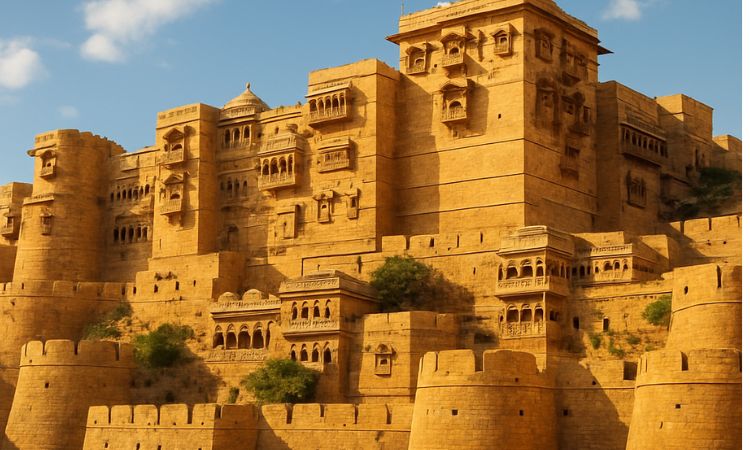
10. Jaisalmer Fort, Jaisalmer, Rajasthan
Jaisalmer Fort, also known as Sonar Quila or the Golden Fort, is one of the most breathtaking and historically rich monuments of India, located in the heart of the Thar Desert in Jaisalmer, Rajasthan. Built in 1156 AD by Rajput ruler Rawal Jaisal, the fort is one of the largest in the world and is unique for being a “living fort,” with thousands of residents still residing within its ancient walls.
Constructed from golden-yellow sandstone, Jaisalmer Fort glows brilliantly under the sun, especially at sunrise and sunset, earning its nickname “Golden Fort.” The fort sits atop Trikuta Hill, offering panoramic views of the surrounding desert landscape. Its massive walls, rising nearly 250 feet above the city, enclose an intricate labyrinth of narrow lanes, richly adorned palaces, ancient temples, houses, and bustling bazaars.
The fort’s architectural style is a perfect blend of Rajput and Islamic influences, with ornate carvings, lattice windows (jharokhas), and intricately designed balconies. Notable attractions within the fort include Raj Mahal (Royal Palace), Jain Temples dating back to the 12th century, and Laxminath Temple, showcasing exquisite craftsmanship.
A UNESCO World Heritage Site as part of the group “Hill Forts of Rajasthan,” Jaisalmer Fort is a testament to India’s rich history and architectural excellence. It has stood resilient through centuries, witnessing battles, trade, and cultural evolution.
As one of the most iconic monuments of India, Jaisalmer Fort continues to captivate visitors with its golden charm, historical depth, and vibrant local life. It offers a rare experience of walking through a living heritage site, where history and everyday life exist side by side, making it a must-visit destination in Rajasthan.
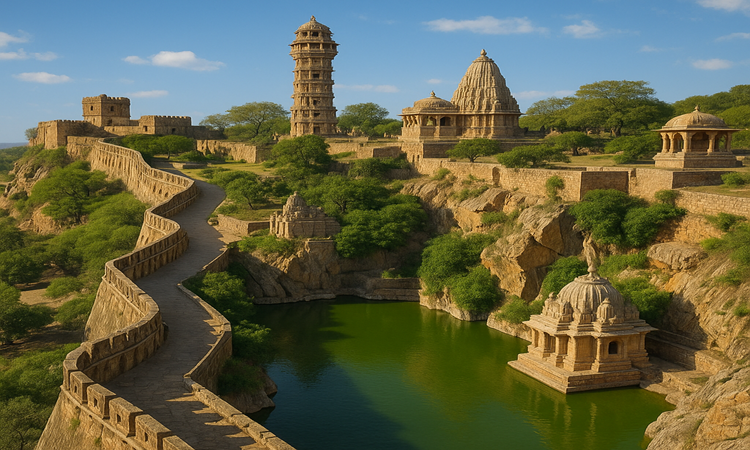
11. Chittorgarh Fort, Chittorgarh, Rajasthan
Chittorgarh Fort, located in Chittorgarh, Rajasthan, is one of the largest and most historically significant monuments of India. Spanning over 700 acres and perched atop a 180-meter-high hill, this majestic fort is a proud symbol of Rajput bravery, sacrifice, and resistance.
Believed to have been originally built in the 7th century by Mauryan rulers and later expanded by the Sisodia Rajputs, the fort served as the capital of the Mewar kingdom. It has witnessed numerous battles, including the legendary sieges by Alauddin Khilji, Bahadur Shah of Gujarat, and Mughal emperor Akbar. Each attack is marked by tales of immense courage and the practice of Jauhar (self-immolation) by Rajput women to preserve their honor.
The fort complex contains several palaces, temples, towers, and reservoirs. Notable structures include the Vijay Stambh (Tower of Victory), built by Maharana Kumbha to commemorate his victory over Mahmud Khilji; the Kirti Stambh (Tower of Fame), a Jain monument; the Rana Kumbha Palace, and the Rani Padmini Palace, linked to the legendary queen Padmini. The fort also houses over 20 intricately carved temples dedicated to Hindu and Jain deities.
Designated a UNESCO World Heritage Site, Chittorgarh Fort stands as a monumental tribute to Rajputana pride, resilience, and architectural splendor. Its extensive ramparts, colossal gateways, and deep historical roots make it a must-visit for those interested in India’s martial history and cultural legacy.
As one of the most iconic monuments of India, Chittorgarh Fort is not just a fortification but a symbol of unwavering courage and heritage. It continues to inspire visitors with its majestic presence and the heroic stories etched into its walls and corridors.
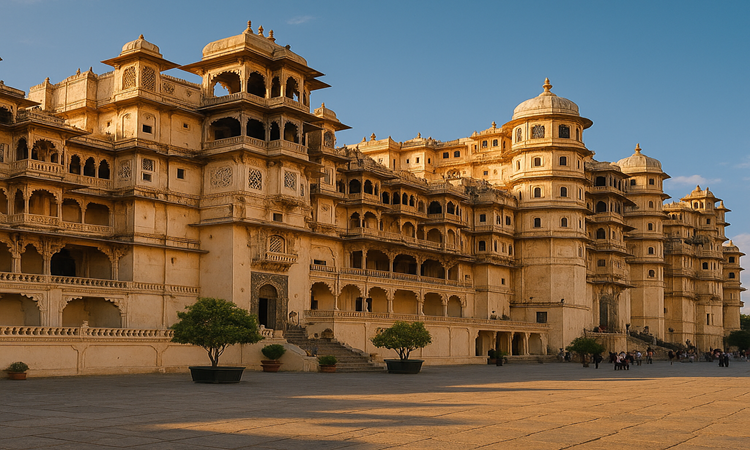
12. Udaipur City Palace, Udaipur, Rajasthan
Udaipur City Palace, nestled on the banks of Lake Pichola in Udaipur, Rajasthan, is one of the most exquisite and majestic monuments of India. Constructed over nearly 400 years, the palace was started by Maharana Udai Singh II in 1553, the founder of Udaipur, and expanded by his successors from the Mewar dynasty. It stands as a shining symbol of Rajput valor, grandeur, and artistic excellence.
Built in a harmonious blend of Rajasthani and Mughal architectural styles, the City Palace is a vast complex comprising several palaces, courtyards, pavilions, terraces, and gardens. The structure is made primarily of granite and marble, adorned with intricately carved balconies, decorative pillars, and colored glass windows. From the palace, visitors can enjoy panoramic views of the city, Lake Pichola, and landmarks like Jag Mandir and the Lake Palace.
The main section open to the public is the City Palace Museum, which houses a vast collection of royal artifacts including weapons, paintings, costumes, and antique furniture. Key attractions within the complex include the Mor Chowk (Peacock Courtyard), Sheesh Mahal (Mirror Palace), Zenana Mahal (Queen’s quarters), and the Krishna Vilas.
Udaipur City Palace is not just a historic monument but also a vibrant cultural center, often hosting royal weddings, traditional festivals, and heritage events. Its majestic architecture, historical richness, and serene setting attract tourists from all over the world.
As one of the most visited monuments of India, Udaipur City Palace offers a glimpse into the opulent lifestyle of the Rajput rulers and serves as a timeless testament to the legacy of Mewar. It remains a must-see destination for anyone exploring the royal heritage of Rajasthan and India’s architectural marvels.
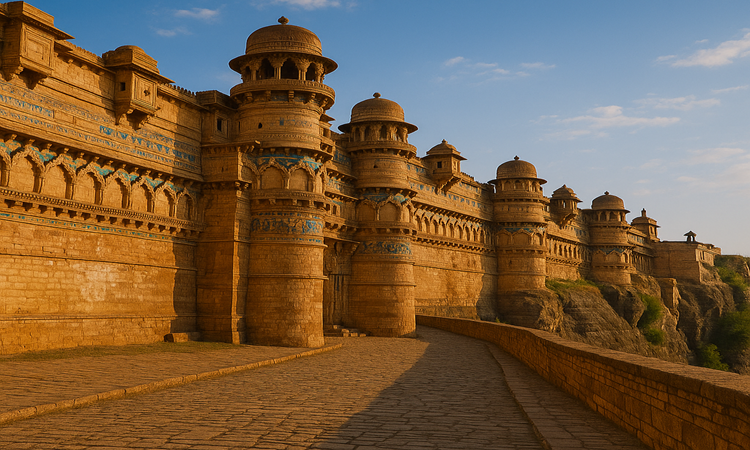
13. Gwalior Fort, Gwalior, Madhya Pradesh
Gwalior Fort, located in Gwalior, Madhya Pradesh, is one of the most magnificent and strategically significant monuments of India. Perched atop a steep sandstone hill, this colossal fort has witnessed centuries of Indian history, royal battles, and architectural evolution. Often referred to as “The Gibraltar of India,” Gwalior Fort is known for its impressive scale, intricate design, and commanding views of the surrounding landscape.
The fort’s origins trace back to around the 6th century, with additions made by various dynasties including the Tomars, Mughals, Marathas, and Scindias. Raja Man Singh Tomar, who ruled in the 15th century, was instrumental in building the most celebrated parts of the fort, including the exquisite Man Mandir Palace—a masterpiece of decorative tile work and lattice screens.
Within the fort complex are several remarkable structures such as Gujari Mahal, built for Queen Mrignayani; Sas Bahu Temples, known for intricate carvings; and Teli Ka Mandir, an unusual blend of Dravidian and North Indian architectural styles. The fort also houses Jain rock-cut temples dating back to the 7th century, showcasing India’s deep-rooted religious harmony and sculptural artistry.
Over the centuries, Gwalior Fort has played a critical role in India’s political and military history, often changing hands among powerful rulers. It also served as a prison for royal captives and was the site of several fierce battles.
Today, Gwalior Fort stands as a UNESCO Tentative World Heritage Site and a prominent tourist destination. As one of the most awe-inspiring monuments of India, it embodies strength, heritage, and artistic brilliance. Its massive gates, elegant palaces, and ancient temples offer a vivid journey through India’s glorious past, making it a must-visit for history lovers and architecture enthusiasts alike.
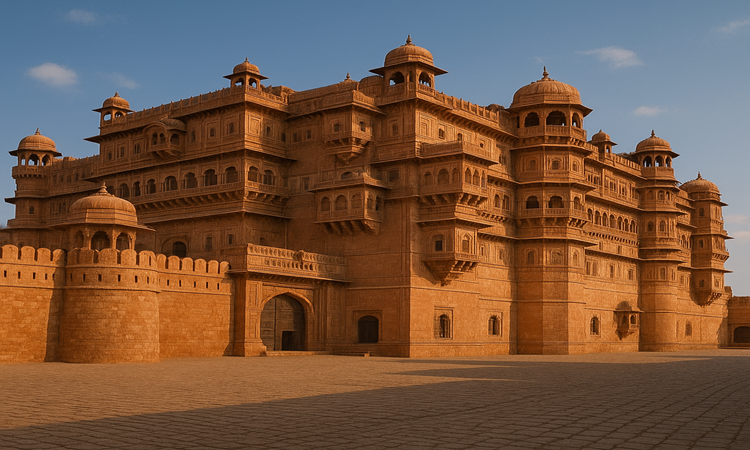
14. Junagarh Fort, Bikaner, Rajasthan
Junagarh Fort, located in Bikaner, Rajasthan, is one of the finest examples of Rajput architecture and a prominent name among the iconic monuments of India. Unlike many forts built on hills, Junagarh Fort stands boldly on the plains of the Thar Desert, showcasing the strength and grandeur of the Bikaner rulers. It was originally built in 1589 by Raja Rai Singh, a general in Emperor Akbar’s army, and later enhanced by successive kings.
The fort complex is surrounded by a high wall and deep moat, protecting its palaces, temples, and pavilions, which are constructed primarily from red sandstone and marble. The architecture beautifully blends Rajputana, Mughal, and Gujarati styles, evident in its intricately carved balconies, lattice windows, and ornate courtyards.
Inside the fort are some of the most stunning structures including the Anup Mahal, Phool Mahal, Badal Mahal, Chandra Mahal, and Ganga Mahal. These palaces are richly decorated with mirrors, gold leaf work, vibrant paintings, and carved wooden ceilings. The Karan Mahal, built to celebrate a victory, stands out for its beautiful design and artistry.
The Junagarh Fort Museum houses an impressive collection of weapons, royal costumes, paintings, manuscripts, and artifacts that narrate the history and culture of Bikaner’s royal lineage. Unlike many forts in Rajasthan, Junagarh was never conquered, which is a testament to its robust defense and strategic design.
As one of the most captivating monuments of India, Junagarh Fort reflects the valor, vision, and opulence of Bikaner’s royal heritage. Its well-preserved architecture, fascinating interiors, and historical significance make it a must-visit destination for tourists exploring Rajasthan’s rich cultural legacy and India’s royal past.
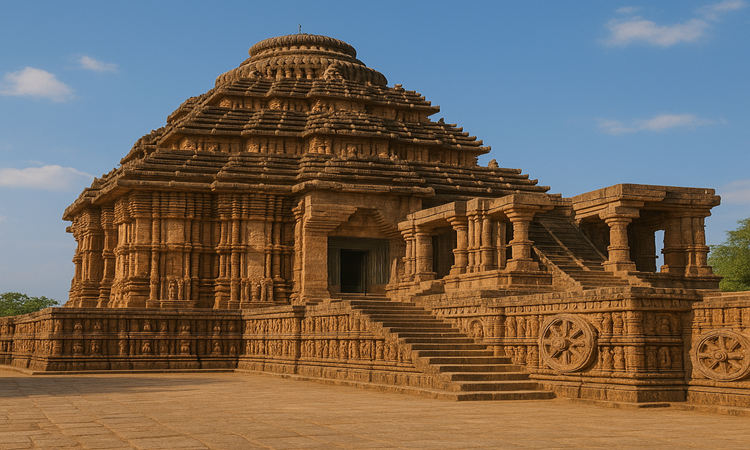
15. Konark Sun Temple, Konark, Odisha
The Konark Sun Temple, located in Konark, Odisha, is one of the most remarkable and iconic monuments of India. Built in the 13th century by King Narasimha Deva I of the Eastern Ganga Dynasty, this majestic temple is dedicated to Surya, the Sun God, and is renowned for its stunning architecture and spiritual significance.
Designed in the form of a giant chariot, the temple represents the sun god’s celestial vehicle, complete with 12 intricately carved stone wheels and seven horses pulling it forward. Each wheel symbolizes a month of the Hindu calendar, and the entire structure aligns perfectly with the movements of the sun. Built primarily from chlorite, laterite, and sandstone, the temple showcases exceptional craftsmanship and artistic vision.
The Konark Sun Temple is an extraordinary example of Kalinga architecture, with elaborate sculptures depicting scenes from mythology, everyday life, animals, dancers, and celestial beings. The carvings on the walls are so detailed and expressive that they continue to fascinate historians, archaeologists, and visitors alike. Despite much of the temple now lying in ruins, its grandeur and spiritual aura remain undiminished.
Recognized as a UNESCO World Heritage Site, the temple not only serves as a symbol of India’s ancient architectural excellence but also as a center of pilgrimage and tourism. The annual Konark Dance Festival, held in the temple’s backdrop, celebrates India’s classical dance forms and cultural heritage.
As one of the most awe-inspiring monuments of India, the Konark Sun Temple is a radiant fusion of devotion, astronomy, and artistry. It stands as a timeless tribute to India’s rich cultural and religious traditions, making it an essential stop for anyone exploring the historical treasures of Odisha and the country at large.
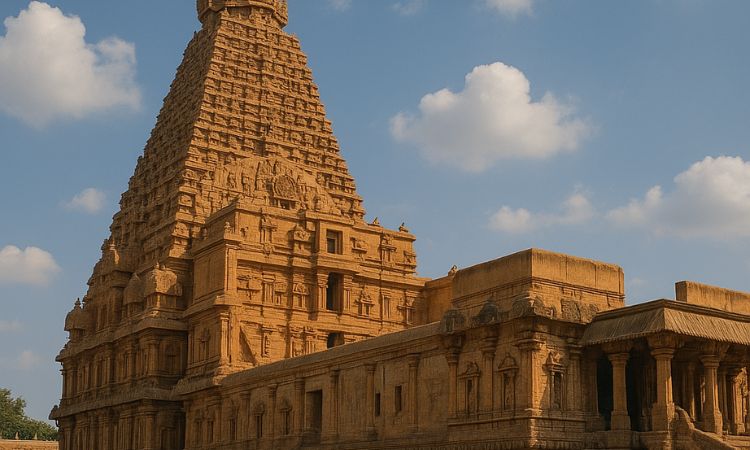
16. Brihadeeswarar Temple, Thanjavur, Tamil Nadu
Brihadeeswarar Temple, also known as Peruvudaiyar Kovil, is one of the most magnificent monuments of India, located in Thanjavur, Tamil Nadu. Built in 1010 AD by the great Chola emperor Raja Raja Chola I, this UNESCO World Heritage Site is a masterpiece of Dravidian architecture and a shining symbol of India’s temple-building tradition.
Dedicated to Lord Shiva, Brihadeeswarar Temple is often referred to as the “Big Temple” due to its monumental scale and grandeur. The temple complex is constructed entirely out of granite, and its most iconic feature is the massive vimana (temple tower), which rises approximately 66 meters (216 feet) above the sanctum—the tallest of its kind in the world. Atop the tower sits a single block of granite weighing about 80 tons, an architectural marvel even by modern standards.
The temple is adorned with intricate carvings and sculptures that depict scenes from Hindu mythology, daily life, and the achievements of the Chola dynasty. The walls of the sanctum also contain exquisite frescoes and inscriptions in Tamil and Sanskrit, providing valuable insights into the period’s culture, governance, and spirituality.
The majestic Nandi Mandapam houses a colossal monolithic statue of Nandi (the sacred bull of Shiva), measuring about 6 meters in length and 4 meters in height—one of the largest in India.
Brihadeeswarar Temple is not only a place of worship but also a beacon of Tamil heritage and artistry. It continues to draw devotees, tourists, and scholars from around the world.
As one of the most iconic monuments of India, Brihadeeswarar Temple stands as a timeless tribute to India’s spiritual depth, architectural ingenuity, and the legacy of the Chola dynasty.
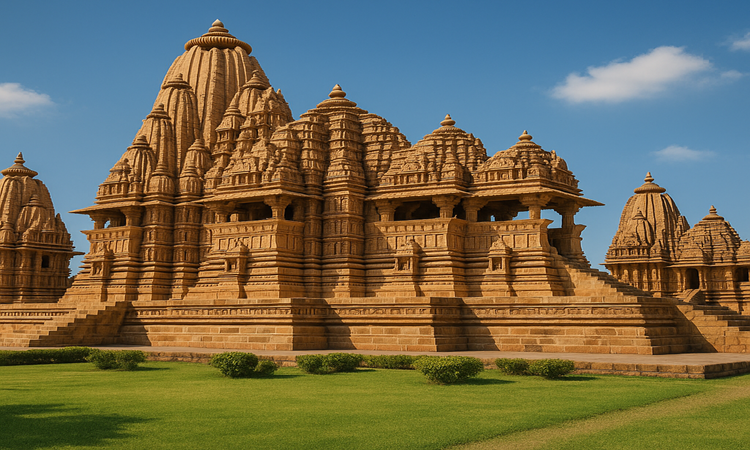
17. Khajuraho Group of Monuments, Madhya Pradesh
The Khajuraho Group of Monuments, located in Madhya Pradesh, is one of the most iconic and artistically significant monuments of India. Built between the 9th and 12th centuries by the Chandela dynasty, these temples are celebrated worldwide for their exquisite carvings, architectural brilliance, and bold depiction of human emotions and sensuality.
Originally, the Khajuraho complex consisted of 85 temples, but only 25 temples have survived the test of time. These temples are divided into three groups—Western, Eastern, and Southern—with the Western Group being the most well-preserved and visited. The most famous temples in this group include Kandariya Mahadev Temple, Lakshmana Temple, and Vishvanatha Temple, all dedicated to Hindu deities like Shiva, Vishnu, and Devi. The Eastern Group features beautiful Jain temples, showcasing religious tolerance and artistic diversity.
What makes Khajuraho unique is its intricate stone carvings that cover almost every inch of the temple walls. These carvings include depictions of deities, apsaras (celestial dancers), animals, musicians, and scenes from everyday life. However, the temples are most famous for their erotic sculptures, which symbolize the celebration of love, life, and the integration of spirituality with physical existence.
A UNESCO World Heritage Site, the Khajuraho temples represent the pinnacle of Nagara-style temple architecture. Despite centuries of natural and human threats, the temples have retained their elegance and continue to attract tourists, historians, and devotees from across the world.
As one of the most enchanting monuments of India, the Khajuraho Group of Monuments stands as a testament to India’s rich artistic heritage, philosophical depth, and architectural mastery. It reflects a civilization that embraced life in all its forms—spiritual, emotional, and sensual—with grace and grandeur.
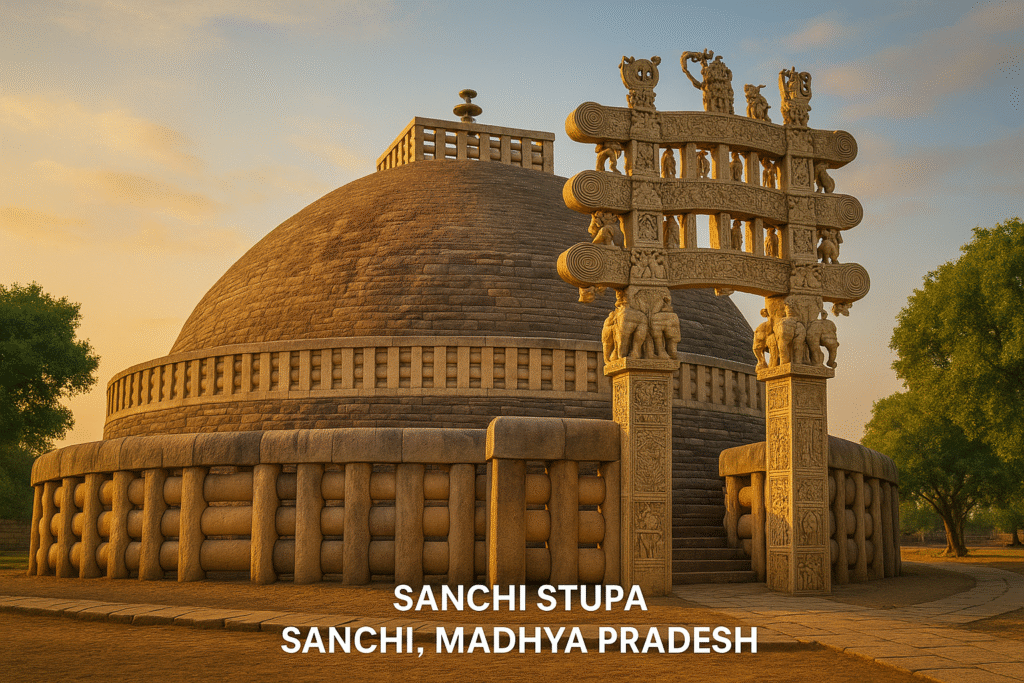
18. Sanchi Stupa, Sanchi, Madhya Pradesh
The Sanchi Stupa, located in the town of Sanchi in Madhya Pradesh, is one of the most significant and well-preserved Buddhist monuments in India. Built during the reign of Emperor Ashoka in the 3rd century BCE, the Great Stupa at Sanchi is a UNESCO World Heritage Site and stands as a symbol of India’s rich spiritual and architectural heritage.
The Great Stupa, also known as Stupa No. 1, is a hemispherical brick structure built over the relics of the Buddha. It was originally a modest structure commissioned by Ashoka but was later enlarged and elaborately decorated in the following centuries, especially during the Shunga and Satavahana periods. The stupa is surrounded by a circular terrace, a stone balustrade, and four beautifully carved gateways known as toranas, facing the cardinal directions.
These toranas are masterpieces of ancient Indian sculpture, depicting scenes from the Jataka tales, which narrate the previous lives of the Buddha. The carvings reflect a blend of symbolism, artistic excellence, and religious devotion, offering insight into early Buddhist iconography and storytelling.
Sanchi is not just a single monument but a complex of stupas, temples, monasteries, and pillars spanning several centuries. It served as a major center for Buddhist learning and pilgrimage. Notably, the site reflects the harmonious coexistence of different artistic and cultural influences over time.
Unlike other Buddhist sites in India that are located in areas associated with the life of the Buddha, Sanchi was never visited by him. Yet, it became an important religious center due to Ashoka’s patronage and the flourishing of the Buddhist Sangha.
Today, Sanchi remains an enduring symbol of India’s ancient Buddhist tradition and architectural genius, drawing scholars, tourists, and spiritual seekers from around the world.
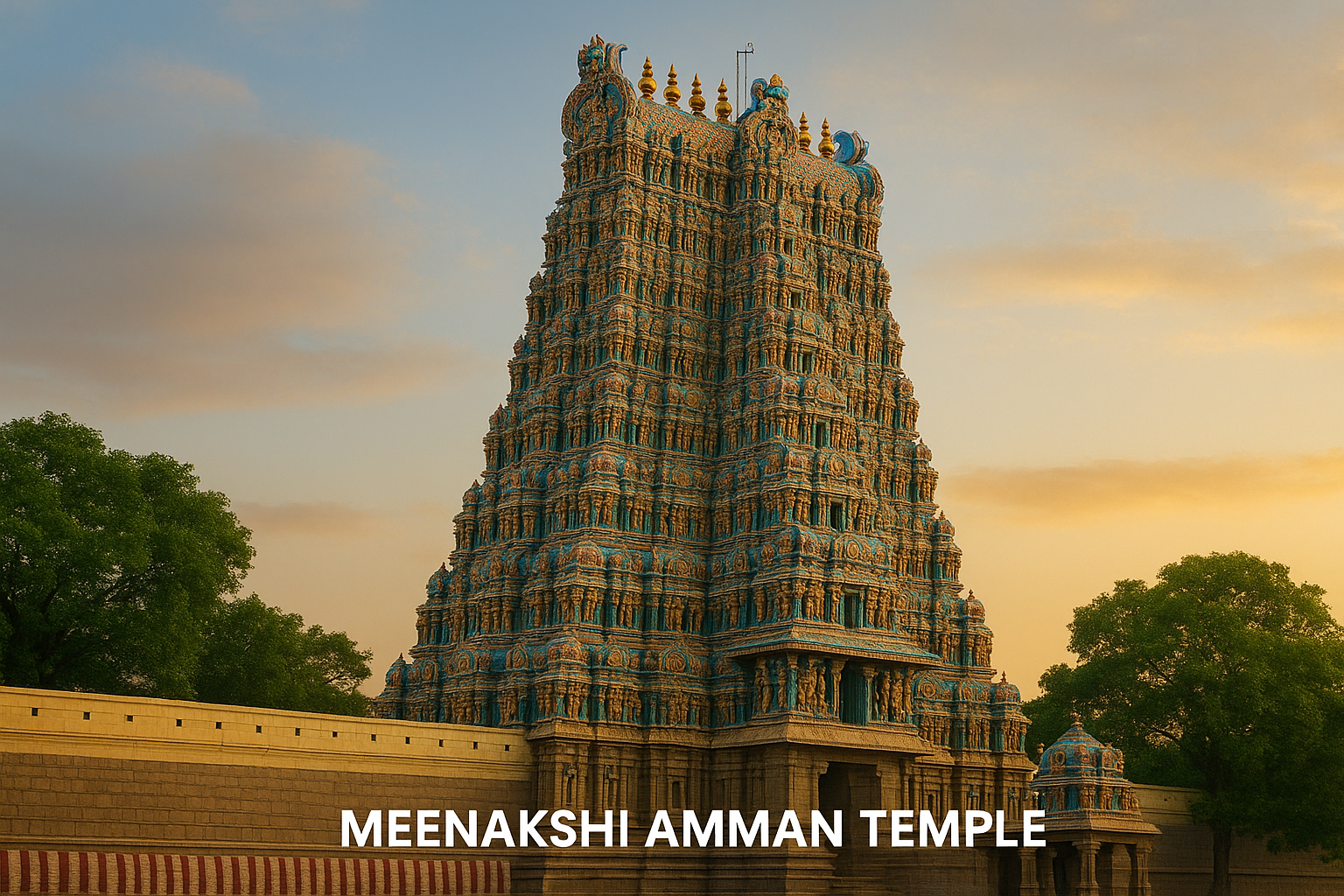
19. Meenakshi Amman Temple, Madurai, Tamil Nadu
The Meenakshi Amman Temple, located in Madurai, Tamil Nadu, is one of the most magnificent and iconic Hindu temples in India. Dedicated to Goddess Meenakshi (a form of Parvati) and her consort Lord Sundareswarar (a form of Shiva), the temple is a brilliant example of Dravidian architecture and a major spiritual and cultural landmark in South India.
Believed to have been originally built around the 6th century CE, the temple gained its current grandeur during the rule of the Nayak dynasty in the 16th and 17th centuries. King Tirumalai Nayak played a significant role in the temple’s expansion and beautification, turning it into the architectural marvel seen today.
The temple complex covers around 14 acres and features 14 towering gopurams (gateway towers), the tallest being the southern gopuram, rising to about 170 feet. These gopurams are adorned with thousands of vividly colored sculptures depicting gods, goddesses, mythical creatures, and scenes from Hindu epics. The central sanctum houses the idols of Meenakshi and Sundareswarar, attracting millions of devotees every year.
One of the temple’s most remarkable features is the “Hall of Thousand Pillars” (Aayiram Kaal Mandapam), where each carved column displays intricate and unique artwork. The temple is also renowned for its sacred tank, the “Porthamarai Kulam,” where devotees take ritual baths.
The Meenakshi Temple is not just a place of worship but also a cultural hub. It hosts the famous Meenakshi Tirukalyanam festival, celebrating the divine marriage of Meenakshi and Sundareswarar, drawing pilgrims and tourists from across India and abroad.
This temple stands as a testament to the artistic brilliance, spiritual depth, and architectural sophistication of ancient and medieval Tamil civilization, making it a treasured monument of India.
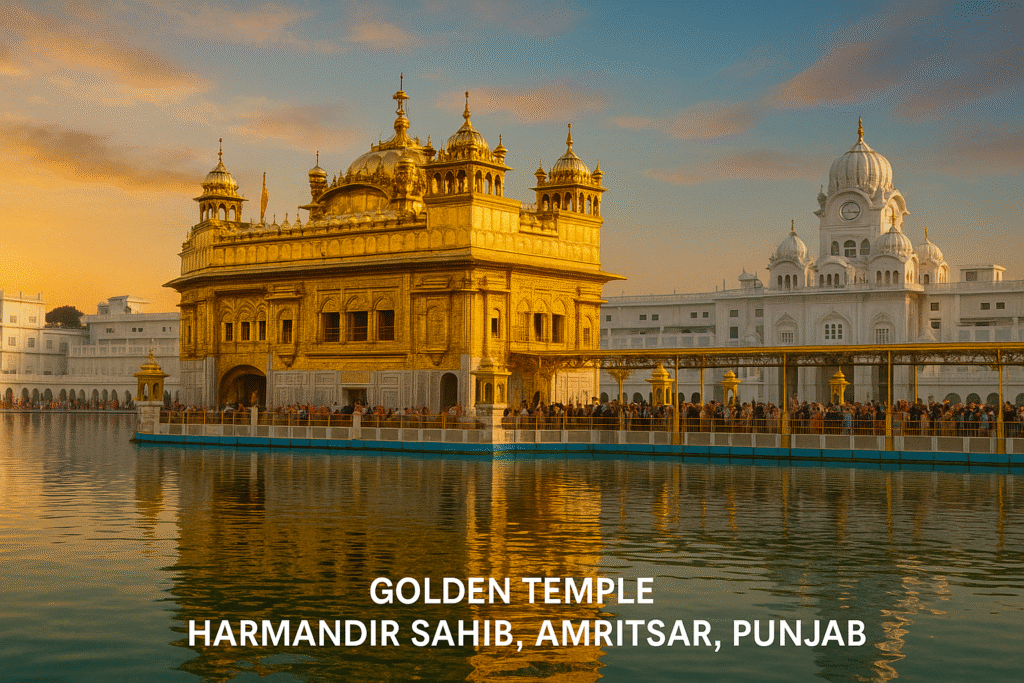
20. Golden Temple (Harmandir Sahib), Amritsar, Punjab
The Golden Temple, also known as Harmandir Sahib, is the holiest shrine of Sikhism and a symbol of spiritual and cultural heritage in India. Located in the city of Amritsar in Punjab, the temple is a stunning example of Sikh architecture and a place of immense reverence and devotion.
The foundation of the Golden Temple was laid in 1581 by Guru Arjan Dev, the fifth Sikh Guru. He also compiled the Adi Granth, the holy scripture of Sikhism, and installed it inside the temple. The temple was later rebuilt and embellished with marble and gold during the early 19th century by Maharaja Ranjit Singh, the Sikh ruler of Punjab. Its dome, gilded with approximately 750 kg of pure gold, gives the temple its popular name – the Golden Temple.
The temple stands in the center of a sacred water tank known as the Amrit Sarovar, from which the city of Amritsar gets its name. A causeway leads to the sanctum, which houses the Guru Granth Sahib, the holy book of the Sikhs, and is recited continuously by priests.
The Golden Temple is open to people of all faiths and backgrounds, reflecting the Sikh principles of equality, humility, and universal brotherhood. One of the most remarkable features of the temple is the community kitchen, or Langar, which serves free meals to thousands of visitors every day regardless of caste, religion, or status.
Architecturally, the Golden Temple is a blend of Hindu and Islamic styles, featuring a graceful marble structure, gold-plated surfaces, and intricate inlay work. The reflection of the temple in the surrounding water creates a serene and mesmerizing sight.
The Golden Temple is not just a place of worship but a symbol of peace, devotion, and humanity, making it one of India’s most iconic monuments.
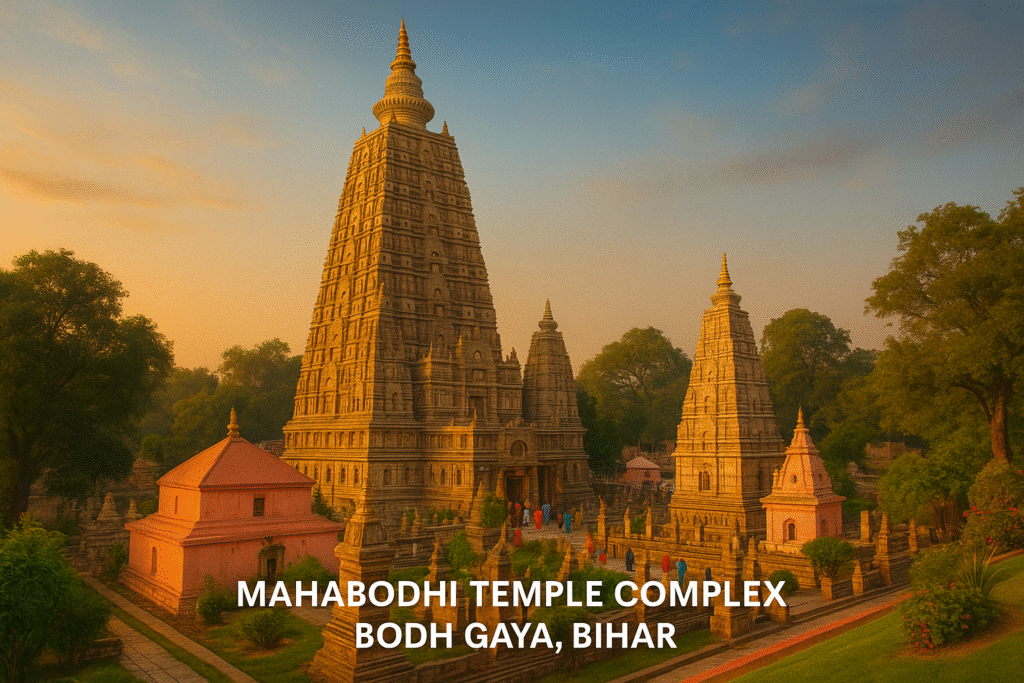
21. Mahabodhi Temple Complex, Bodh Gaya, Bihar
The Mahabodhi Temple Complex, located in Bodh Gaya, Bihar, is one of the most significant and revered monuments of India. It marks the location where Siddhartha Gautama, later known as Buddha, attained enlightenment under the Bodhi Tree around the 6th century BCE. This site is a key pilgrimage destination for Buddhists worldwide and holds immense historical and religious importance.
The current structure of the Mahabodhi Temple dates back to the 5th–6th century CE, although the original shrine was built by Emperor Ashoka in the 3rd century BCE. The temple complex was restored and preserved over centuries and was declared a UNESCO World Heritage Site in 2002 due to its outstanding cultural value.
Architecturally, the temple is an example of early brick work in India, rising to a height of about 55 meters. The pyramidal spire and intricate carvings reflect the influence of Gupta architecture. Within the temple, a large seated statue of Buddha in the Bhumisparsha Mudra (earth-touching gesture) symbolizes the moment of enlightenment.
Adjacent to the temple is the descendant of the original Bodhi Tree, under which Buddha is believed to have meditated. Other notable features within the complex include the Vajrasana (Diamond Throne), Animesh Lochana Chaitya, and numerous stupas and votive structures built by devotees from different countries.
The Mahabodhi Temple Complex is managed by the Bodh Gaya Temple Management Committee and continues to serve as a center for meditation, learning, and interfaith dialogue.
As one of the prominent monuments of India, the Mahabodhi Temple Complex is not only an architectural heritage site but also a spiritual landmark that represents the foundation of Buddhism and its global influence.
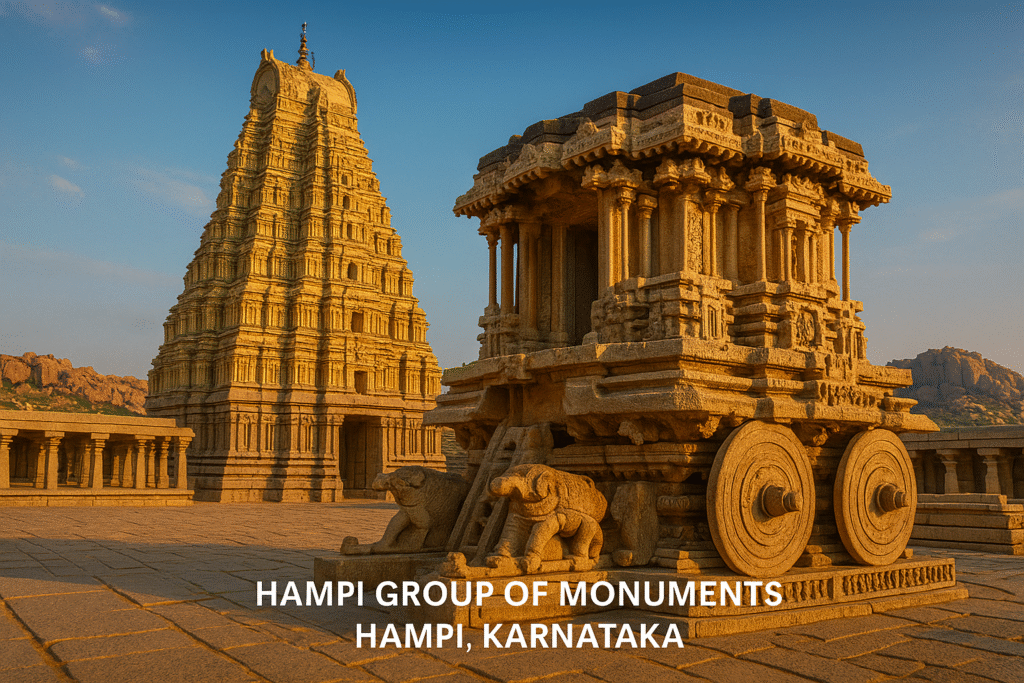
22. Hampi Group of Monuments, Hampi, Karnataka
The Hampi Group of Monuments, located in Karnataka, is one of the most extraordinary and historically rich monuments of India. Spread across the ruins of the ancient city of Vijayanagara, Hampi was once the glorious capital of the Vijayanagara Empire, one of the richest and most powerful kingdoms in South India during the 14th to 16th centuries.
Designated as a UNESCO World Heritage Site, Hampi is renowned for its captivating landscape dotted with temples, palaces, market streets, fortifications, and water structures, all set amidst giant granite boulders and lush greenery. The site is a living museum that reflects the grandeur of Dravidian architecture and the wealth of its historical era.
One of the most iconic structures in Hampi is the Virupaksha Temple, dedicated to Lord Shiva, which continues to be an active site of worship. Other notable monuments include the Vittala Temple, famous for its intricately carved stone chariot and musical pillars, and the Hazara Rama Temple, known for its detailed bas-reliefs depicting scenes from the Ramayana.
The Lotus Mahal, Queen’s Bath, Elephant Stables, and the Royal Enclosure are architectural marvels that showcase the sophisticated urban planning and artistic excellence of the Vijayanagara rulers. Hampi also features several monolithic sculptures, including those of Lakshmi Narasimha, Ganesha, and Shiva Lingas carved from single granite stones.
Hampi’s rich cultural and historical heritage, combined with its surreal natural beauty, makes it a top destination for heritage tourism.
As one of the most iconic monuments of India, the Hampi Group of Monuments stands as a timeless symbol of artistic splendor, imperial power, and spiritual devotion—offering visitors a glimpse into the magnificent past of Southern India.
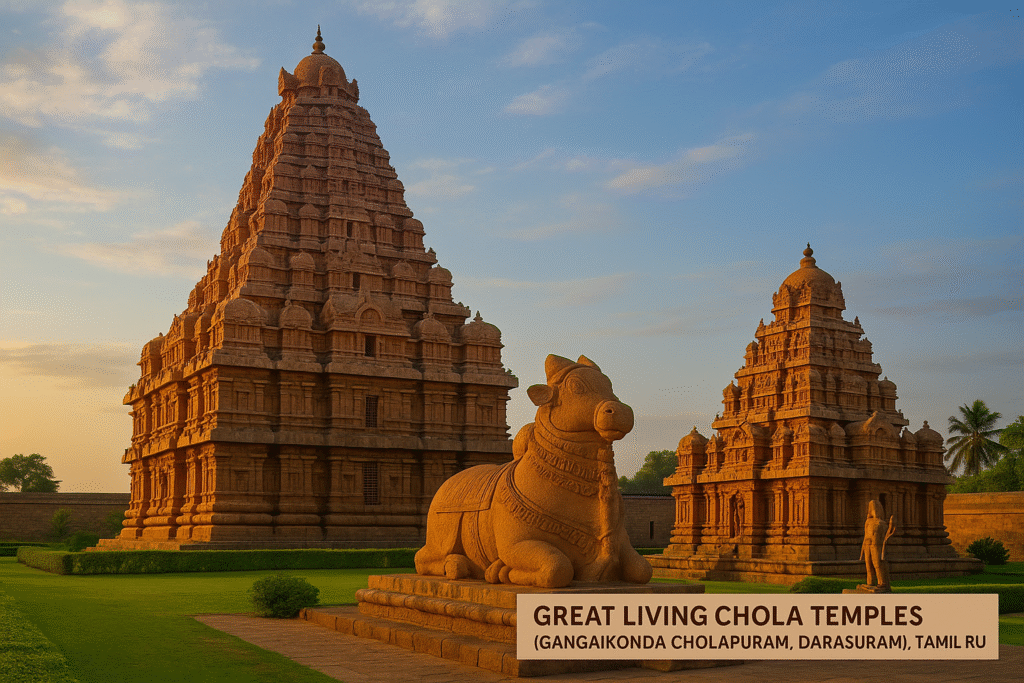
23. Great Living Chola Temples (Gangaikonda Cholapuram, Darasuram), Tamil Nadu
The Great Living Chola Temples, comprising Gangaikonda Cholapuram, Darasuram, and Brihadeeswarar Temple (Thanjavur), are UNESCO World Heritage Sites that represent the architectural brilliance and cultural grandeur of the Chola dynasty in Tamil Nadu. These temples are among the most significant and well-preserved monuments of India, showcasing the Cholas’ devotion, engineering skill, and artistic excellence.
Gangaikonda Cholapuram, built by Rajendra Chola I in the 11th century, was meant to rival the grand Brihadeeswarar Temple built by his father, Raja Raja Chola I. The temple features a towering vimana (temple tower), beautifully carved sculptures, and an enormous Shiva Lingam. It reflects the Chola style with graceful detailing, symmetrical layout, and exquisite iconography. The temple served not only as a religious center but also as a symbol of Rajendra Chola’s conquests and imperial authority.
Darasuram’s Airavatesvara Temple, built by Rajaraja Chola II in the 12th century, is smaller in scale but remarkable for its intricate stone carvings. Dedicated to Lord Shiva, the temple’s pillars and walls are adorned with fine sculptures depicting mythological stories, deities, and celestial beings. The stone chariot in front of the temple is a striking feature, reminiscent of the one at Hampi’s Vittala Temple.
Both temples are examples of the Dravidian architectural style, marked by high vimanas, ornate gopurams, mandapas, and intricate sculptures. They demonstrate advanced knowledge in construction, astronomy, and temple planning.
As part of the Great Living Chola Temples, Gangaikonda Cholapuram and Darasuram stand as enduring symbols of Tamil heritage and are celebrated monuments of India that continue to draw historians, pilgrims, and architecture enthusiasts from around the world.
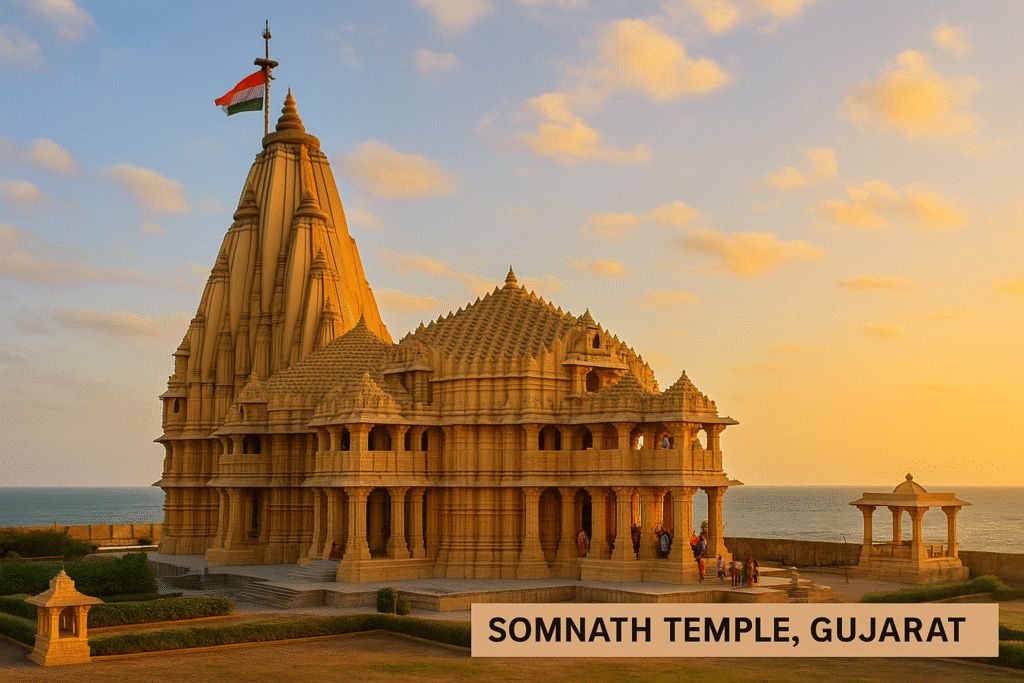
24. Somnath Temple, Gujarat
The Somnath Temple, located in Prabhas Patan, Gujarat, is one of the most sacred and historically significant monuments of India. Revered as the first of the twelve Jyotirlingas of Lord Shiva, Somnath has been a prominent pilgrimage site for centuries. Its spiritual aura, coupled with its storied past of destruction and reconstruction, makes it a true symbol of India’s resilience and unwavering faith.
Believed to have been originally built by the Moon God (Soma) in gold, the temple was later reconstructed by Ravana in silver, Krishna in wood, and finally by Bhimdev in stone. Throughout history, Somnath faced multiple invasions and was destroyed several times, most notably by Mahmud of Ghazni in 1025 AD. However, each time it was rebuilt with greater magnificence, reflecting the unbreakable spirit of its devotees.
The present-day structure was reconstructed in 1951 under the guidance of Sardar Vallabhbhai Patel and is an excellent example of Chalukyan architecture. The temple is adorned with intricate carvings, a massive shikhara (spire) rising about 50 meters high, and a beautiful mandap (hall) with a grand Nandi statue facing the sanctum.
One of the unique features of Somnath Temple is its “Arrow Pillar” (Baan Stambh), which carries an inscription stating that there is no landmass in a straight line between the temple and the South Pole, highlighting its strategic location.
Overlooking the Arabian Sea, the Somnath Temple offers not just a divine experience but also a deep connection to India’s cultural, historical, and spiritual heritage.
As one of the most iconic monuments of India, the Somnath Temple stands as a living testament to the country’s devotion, architectural legacy, and the eternal triumph of faith over adversity.
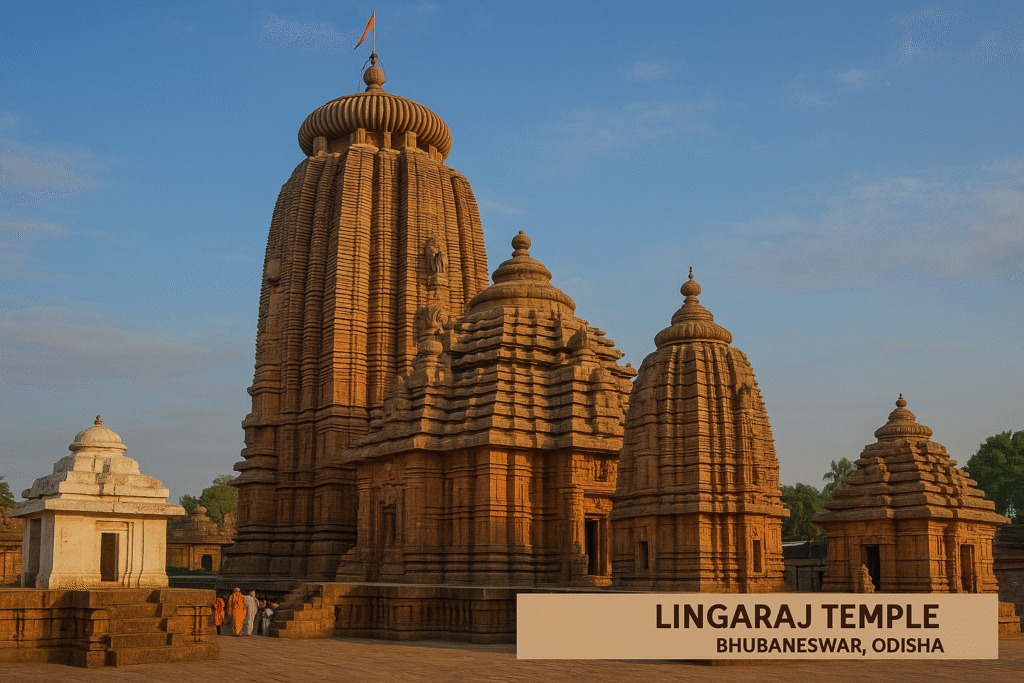
25. Lingaraj Temple, Bhubaneswar, Odisha
The Lingaraj Temple, located in Bhubaneswar, Odisha, is one of the finest examples of Hindu temple architecture and a prominent site among the ancient monuments of India. Dedicated to Lord Shiva, the temple represents the pinnacle of Kalinga architecture and reflects the cultural richness of the region. It is believed to have been built in the 11th century CE by the Somavamsi dynasty and later enhanced by the Ganga rulers.
The temple complex spans over 250,000 square feet, enclosed by a high boundary wall. The main shrine rises to about 180 feet, dominating the skyline of Bhubaneswar, which is also known as the “Temple City of India.” The temple is constructed primarily from sandstone and features a Rekha Deula-style shikhara (tower) above the sanctum. The complex houses over 50 smaller shrines, each dedicated to different Hindu deities.
A unique aspect of Lingaraj Temple is that the presiding deity, Harihara, is a combined form of Lord Shiva and Lord Vishnu, symbolizing religious harmony. The central idol is a massive lingam, made of granite and bathed daily with water, milk, and bhang (cannabis), as part of traditional rituals.
The temple’s architecture is richly adorned with intricate carvings of gods, goddesses, dancers, and scenes from mythology. These artistic details reflect Odisha’s mastery in stone sculpture and craftsmanship. The temple’s annual festivals, such as Shivaratri and Chandan Yatra, draw thousands of devotees and tourists.
Non-Hindus are not allowed inside the sanctum, but they can view the temple from an elevated platform nearby.
As one of the most revered and ancient monuments of India, the Lingaraj Temple stands as a magnificent testament to India’s spiritual legacy, architectural brilliance, and centuries-old devotion to divine power.
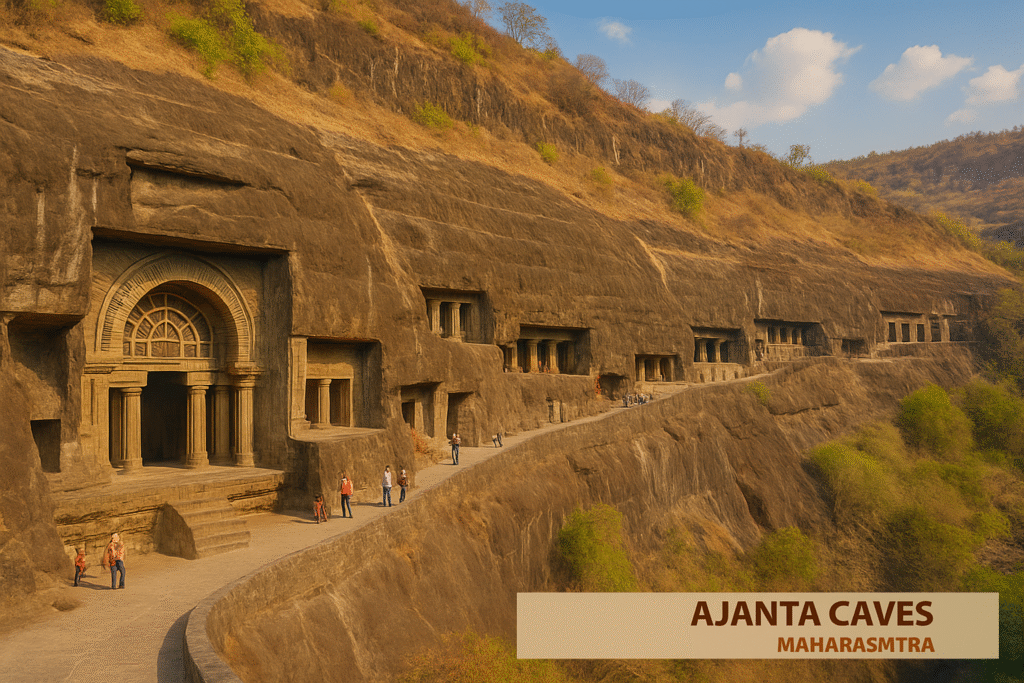
26. Ajanta Caves, Maharashtra
The Ajanta Caves, located in the Aurangabad district of Maharashtra, are among the most significant ancient monuments of India, representing the pinnacle of Indian art, culture, and spirituality. These rock-cut caves, carved between the 2nd century BCE and 6th century CE, are nestled in a horseshoe-shaped cliff along the Waghora River. They form a UNESCO World Heritage Site and are celebrated globally for their extraordinary Buddhist murals, sculptures, and architecture.
There are 30 caves in total, which include chaityas (prayer halls) and viharas (monasteries). These caves served as a spiritual retreat for Buddhist monks and were used for study, meditation, and worship. The Ajanta Caves reflect the Hinayana and Mahayana phases of Buddhism, with early caves containing simple stupas and later ones richly adorned with paintings and sculptures of the Buddha and Bodhisattvas.
The paintings in Ajanta are especially renowned for their vibrant colors, detailed expressions, and storytelling finesse. They depict various Jataka tales, illustrating the past lives of the Buddha, along with scenes of royal courts, everyday life, and nature. Created with natural pigments, these frescoes have survived centuries, displaying the genius of ancient Indian artists.
Sculptures within the caves include elegant carvings of seated Buddhas, ornate pillars, and symbolic motifs. The artistic precision and emotional depth conveyed in these works highlight the cultural and spiritual richness of the time.
Ajanta Caves are not only architectural and artistic marvels but also spiritual symbols of India’s ancient Buddhist heritage. They attract art lovers, historians, pilgrims, and tourists from around the world.
As one of the finest examples of rock-cut architecture and religious art, the Ajanta Caves truly deserve their place among the most awe-inspiring monuments of India.
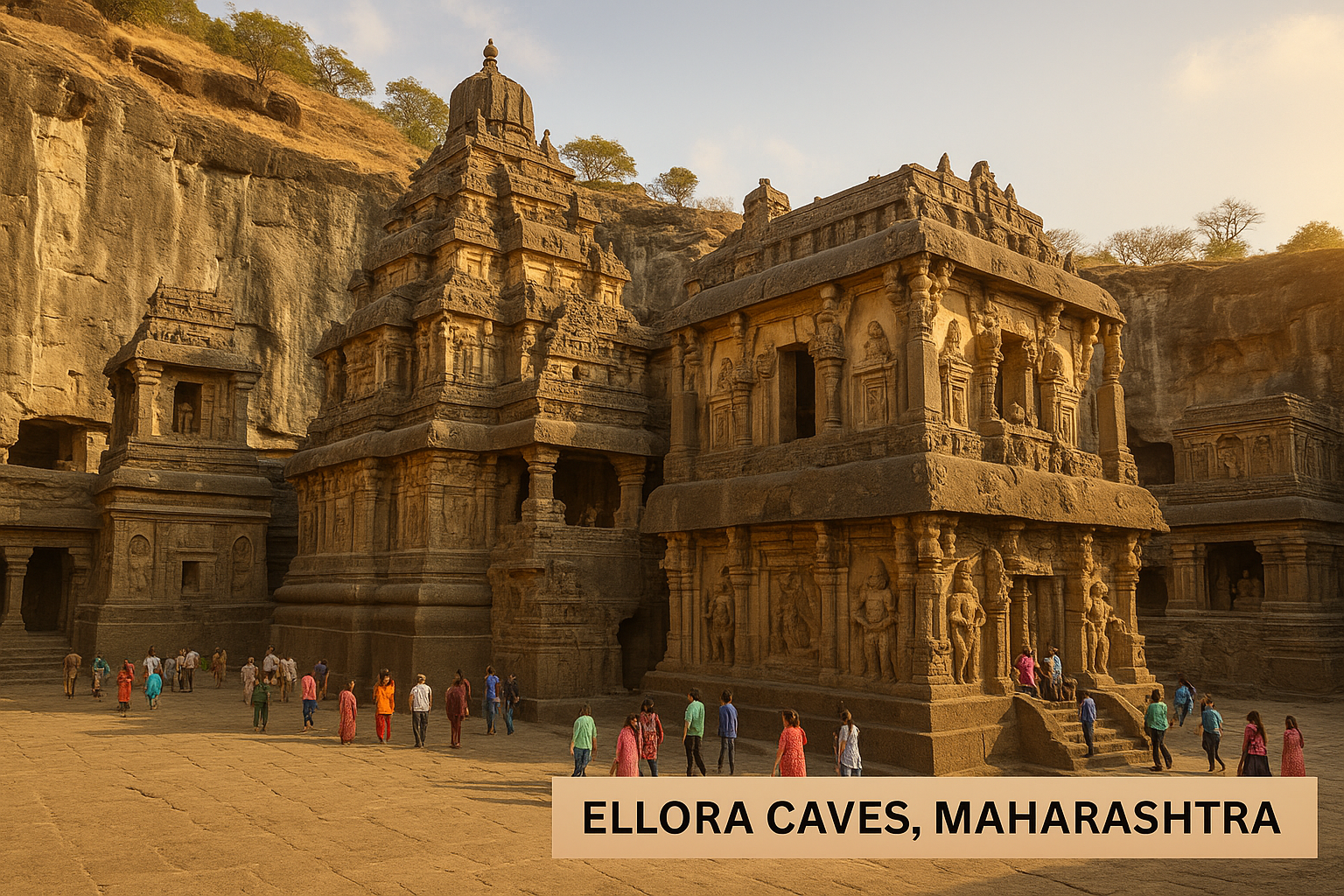
27. Ellora Caves, Maharashtra
The Ellora Caves, located near Aurangabad in Maharashtra, stand as one of the most awe-inspiring monuments of India, showcasing the country’s rich cultural and religious diversity. Carved between the 6th and 10th centuries CE, Ellora is a UNESCO World Heritage Site and features 34 rock-cut caves that represent three major religions: Buddhism, Hinduism, and Jainism.
These caves are divided into three sections: 12 Buddhist caves (Caves 1–12), 17 Hindu caves (Caves 13–29), and 5 Jain caves (Caves 30–34). The coexistence of these religious monuments in a single complex illustrates India’s age-old spirit of tolerance and harmony.
The most spectacular attraction at Ellora is the Kailasa Temple (Cave 16), dedicated to Lord Shiva. This colossal monolithic structure was carved out of a single rock and is considered one of the greatest achievements of ancient Indian architecture. The temple includes intricately carved pillars, elaborate sculptures of gods and celestial beings, and two massive stone elephants at the entrance. What makes it especially remarkable is that it was excavated from the top down—a feat of engineering brilliance.
The Buddhist caves feature prayer halls (chaityas), monasteries (viharas), and serene sculptures of the Buddha. The Jain caves are notable for their detailed carvings, reflecting the strict aesthetic and philosophical ideals of Jainism.
Ellora Caves not only serve as a testament to India’s artistic mastery but also provide insight into the social, cultural, and religious life of ancient India. The carvings, architecture, and symbolism in the caves continue to inspire awe and admiration.
As one of the most treasured monuments of India, the Ellora Caves are a living museum of India’s glorious past and a shining symbol of unity in diversity.
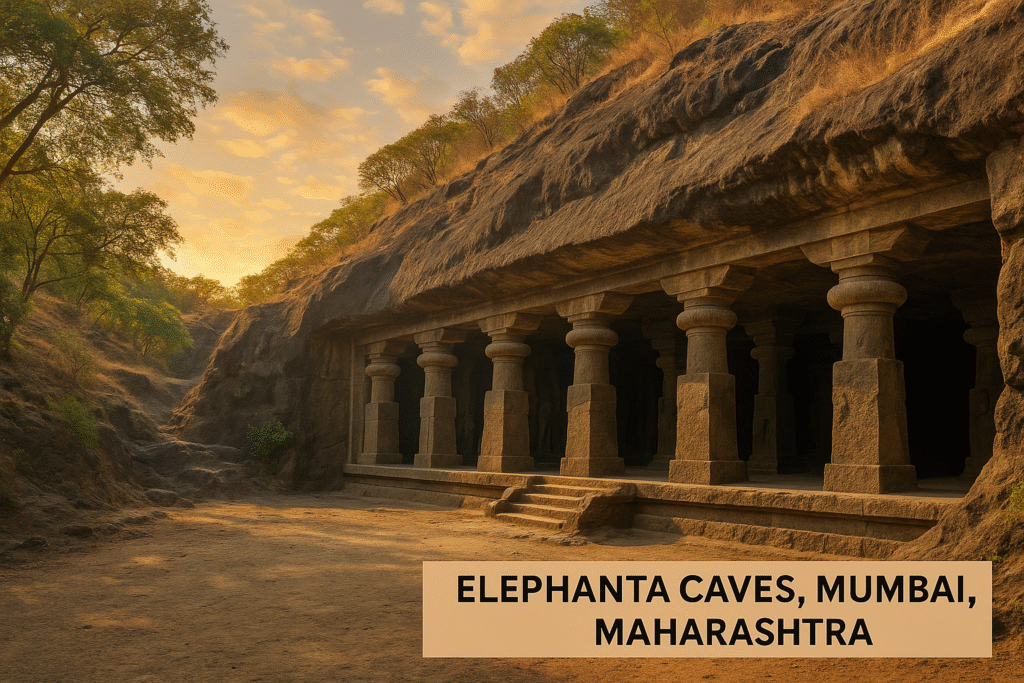
28. Elephanta Caves, Mumbai, Maharashtra
The Elephanta Caves, located on Elephanta Island about 11 kilometers from Mumbai, are among the most remarkable ancient monuments of India. Recognized as a UNESCO World Heritage Site, these rock-cut caves are famous for their stunning sculptures and deep spiritual significance, particularly in Hinduism.
Believed to have been carved between the 5th and 8th centuries CE, the Elephanta Caves consist of seven caves, including five Hindu caves and two Buddhist caves. The main cave, known as Cave 1, is the most prominent and houses some of the most exquisite sculptures dedicated to Lord Shiva. It is designed like a grand temple with pillared halls, a sanctum sanctorum, and intricately carved panels.
The most iconic sculpture in the Elephanta Caves is the Trimurti, a 20-foot-tall relief portraying the three aspects of Shiva—Creator (Brahma), Preserver (Vishnu), and Destroyer (Mahesh). This sculpture is not only a masterpiece of Indian art but also a symbol of the divine cosmic functions. Other important depictions include Ardhanarishvara (a composite of Shiva and Parvati), Gangadhara (Shiva bearing the Ganges), and Nataraja (Shiva as the cosmic dancer).
The caves were named “Elephanta” by Portuguese explorers after they discovered a large stone elephant sculpture near the island’s entrance, which is now displayed at Mumbai’s Jijamata Udyan.
Accessible via a scenic ferry ride from Mumbai’s Gateway of India, the Elephanta Caves are a popular destination for tourists, history buffs, and spiritual seekers alike.
As one of the most important heritage monuments of India, the Elephanta Caves reflect the exceptional skill of ancient Indian artisans and the enduring spiritual legacy that continues to inspire reverence and wonder to this day.
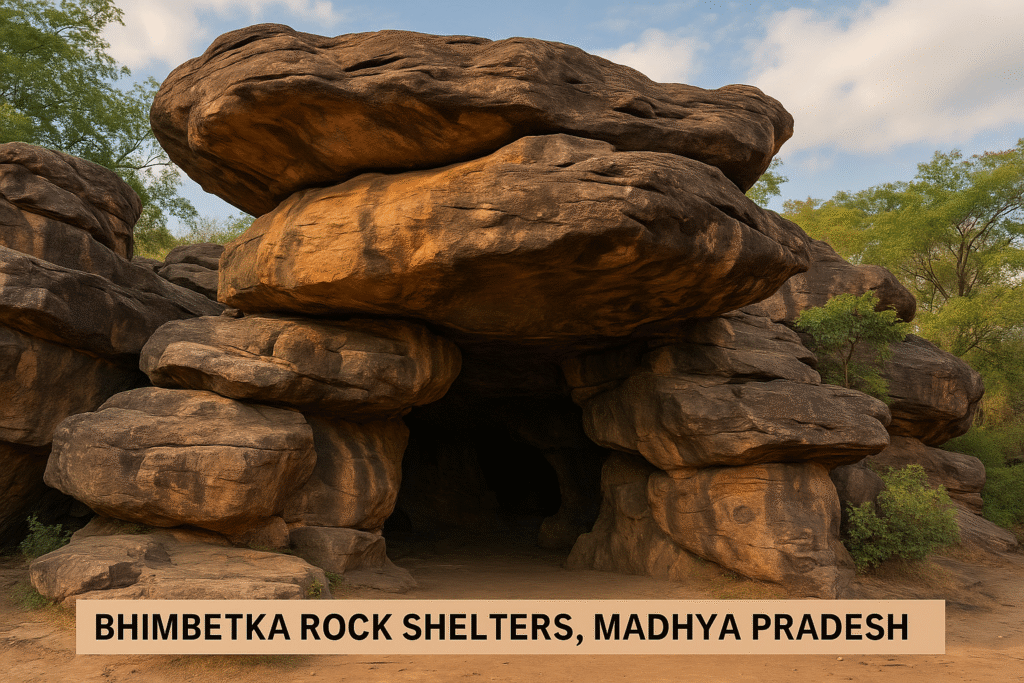
29. Bhimbetka Rock Shelters, Madhya Pradesh
The Bhimbetka Rock Shelters, located in the Raisen district of Madhya Pradesh, are among the most ancient and fascinating monuments of India. These rock shelters offer a window into early human life and stand as a testimony to India’s rich prehistoric heritage. Recognized as a UNESCO World Heritage Site, Bhimbetka is an archaeological treasure trove that dates back to the Paleolithic and Mesolithic periods, with some cave paintings believed to be over 30,000 years old.
Set in the foothills of the Vindhya Range, the site comprises more than 700 rock shelters, out of which around 400 contain paintings and other forms of prehistoric art. These shelters were discovered in the 1950s by archaeologist Dr. V.S. Wakankar, who realized their significance while exploring the region.
The cave paintings in Bhimbetka are remarkable for their vibrant colors, clarity, and diversity. They depict scenes of daily life such as hunting, dancing, animal fights, and communal gatherings, using natural pigments made from minerals. The artworks illustrate not only the creativity of early humans but also their close relationship with nature and wildlife.
Apart from paintings, Bhimbetka also houses evidence of early human settlement, including tools, stone implements, and burial remains. The shelters are believed to have been continuously inhabited by various human communities over thousands of years.
The name “Bhimbetka” is derived from the word “Bhima’s sitting place,” linking the site to the legendary hero Bhima from the Indian epic Mahabharata.
As one of the oldest known human habitats in the Indian subcontinent, the Bhimbetka Rock Shelters are truly exceptional monuments of India, offering valuable insights into the evolution of human culture, art, and civilization. They remain an enduring symbol of India’s deep-rooted history and artistic legacy.
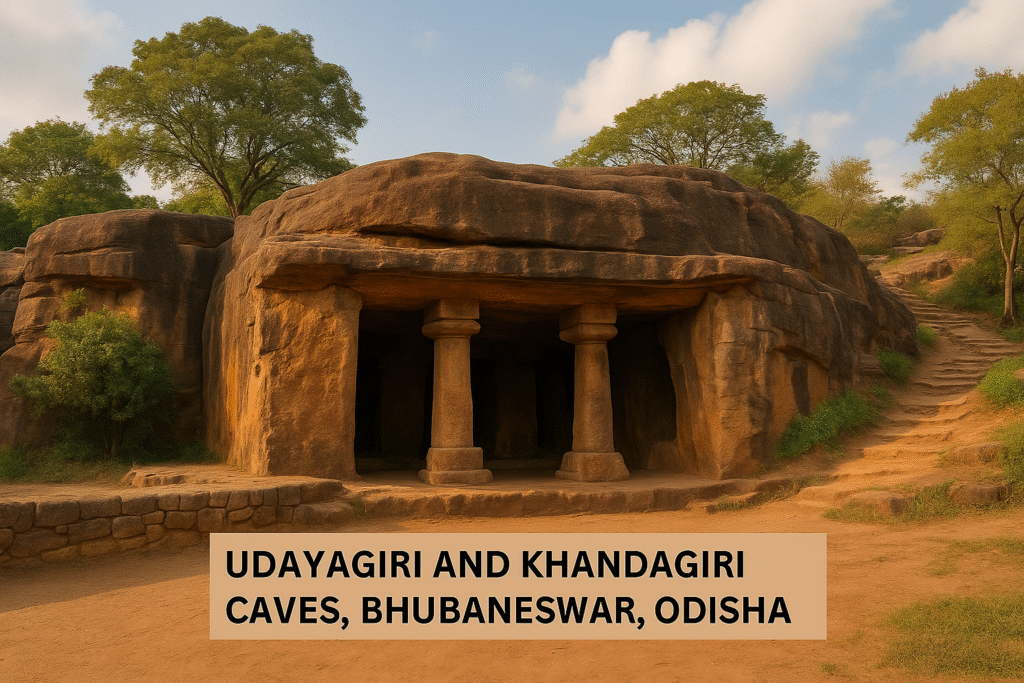
30. Udayagiri and Khandagiri Caves, Bhubaneswar, Odisha
The Udayagiri and Khandagiri Caves, located near Bhubaneswar in Odisha, are remarkable examples of India’s ancient rock-cut architecture and hold an important place among the historic monuments of India. These twin hills, dotted with intricately carved caves, are believed to have been carved during the reign of King Kharavela of the Mahameghavahana dynasty in the 1st century BCE.
These caves served as residential and meditation spaces for Jain monks, making them significant for understanding the religious and cultural landscape of ancient India. Out of the total 33 caves, Udayagiri has 18 caves, while Khandagiri has 15. They are renowned for their artistic brilliance, spiritual significance, and inscriptions.
One of the most famous caves in Udayagiri is the Rani Gumpha (Queen’s Cave), a double-storied cave with elaborate sculptures, decorative motifs, and scenes of court life, hunting, and entertainment. Other notable caves include Hathi Gumpha (Elephant Cave), which bears a significant inscription detailing King Kharavela’s military conquests and charitable deeds, making it an important historical record.
The caves of Khandagiri are less ornate but still impressive, showcasing Jain symbols, motifs, and reliefs of Tirthankaras. The Ananta Cave and Tatowa Gumpha are particularly noted for their religious carvings and spiritual ambiance.
These caves also offer panoramic views of the surrounding city and serve as an important pilgrimage site for followers of Jainism. Tourists and historians visit them not only for their artistic value but also for their historical insights into Jain culture and the socio-political environment of ancient Odisha.
As one of the finest examples of early Jain rock-cut architecture, the Udayagiri and Khandagiri Caves remain vital cultural landmarks among the ancient monuments of India, echoing the voices and visions of a bygone era.
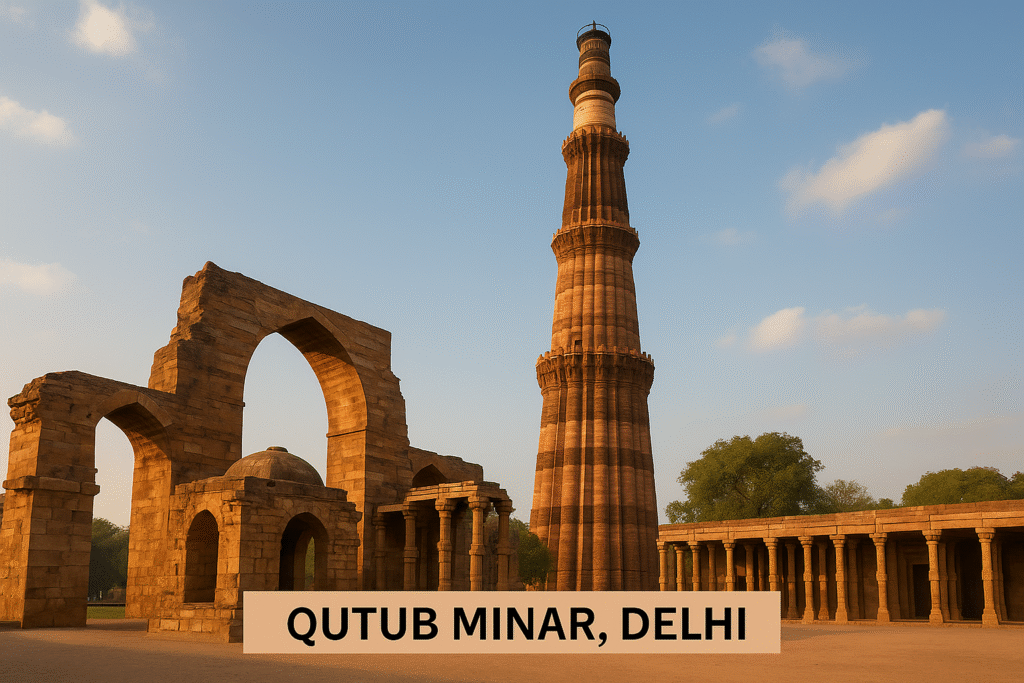
31. Qutub Minar, Delhi
The Qutub Minar, located in Delhi, is one of the most iconic and historic monuments of India. Soaring to a height of 73 meters (240 feet), it is the tallest brick minaret in the world and a UNESCO World Heritage Site. Built in the early 13th century, Qutub Minar marks the beginning of Muslim rule in India and reflects the architectural brilliance of the Delhi Sultanate period.
Construction of the Qutub Minar was initiated by Qutb-ud-din Aibak in 1192, the founder of the Delhi Sultanate, and later completed and expanded by his successors, including Iltutmish and Firoz Shah Tughlaq. The minaret is made of red sandstone and marble, and its five distinct storeys are adorned with intricate carvings and Quranic inscriptions.
The tower has a tapering design with balconies on each level, supported by elaborately decorated brackets. The first three storeys are built in red sandstone, while the fourth and fifth storeys use a combination of sandstone and marble. Its fluted surface, alternating angular and rounded shafts, and detailed Arabic calligraphy make it a masterpiece of Indo-Islamic architecture.
Qutub Minar is part of the larger Qutub Complex, which includes several other historical structures such as the Quwwat-ul-Islam Mosque—the first mosque built in India—and the famous Iron Pillar, which dates back to the 4th century and is known for its rust-resistant composition.
The monument attracts millions of tourists, historians, and architecture enthusiasts every year. It stands not just as a symbol of victory and architectural ingenuity but also as a lasting reminder of India’s layered and diverse historical legacy.
As one of the most visited and celebrated monuments of India, the Qutub Minar remains a towering tribute to the country’s rich cultural and architectural heritage.
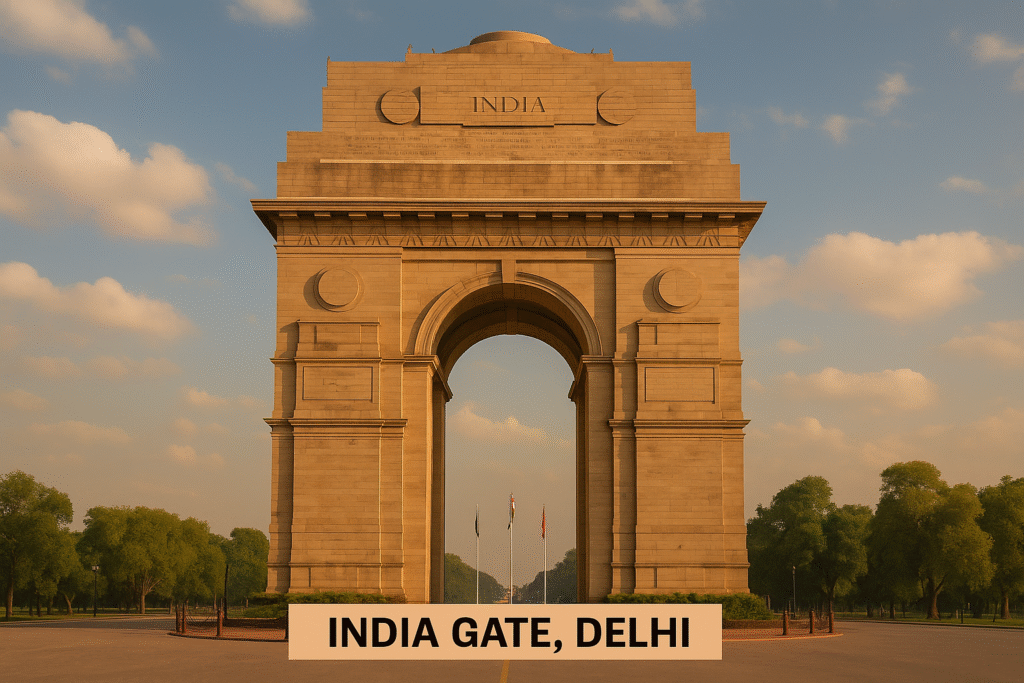
32. India Gate, Delhi
The India Gate, located in the heart of New Delhi, is one of the most iconic war memorials and celebrated monuments of India. Designed by Sir Edwin Lutyens, this grand archway stands at a height of 42 meters and was built in 1931 to honor the 82,000 Indian soldiers who lost their lives fighting for the British Army during World War I and the Third Anglo-Afghan War.
Constructed from red and pale sandstone and granite, the structure is inspired by the Arc de Triomphe in Paris. The names of over 13,000 soldiers, including some British officers, are inscribed on the surface of the gate, making it a solemn symbol of sacrifice and patriotism.
In 1971, after the Indo-Pak war, the Amar Jawan Jyoti (Flame of the Immortal Soldier) was added beneath the arch to commemorate the unknown soldiers who died in the line of duty. This eternal flame, guarded by soldiers from the Indian armed forces, remains a powerful symbol of India’s respect and gratitude toward its military heroes.
Surrounded by lush green lawns, India Gate is not only a place of remembrance but also a popular spot for families, tourists, and evening gatherings. At night, the structure is beautifully illuminated, creating a majestic and serene atmosphere.
India Gate also hosts the Republic Day Parade every year on 26th January, a grand event that showcases India’s military strength and cultural diversity. This further enhances its significance as a national monument.
As one of the most visited and respected monuments of India, India Gate stands as a proud reminder of the country’s history, courage, and collective memory. It is a tribute to those who laid down their lives so the nation could stand tall in freedom and unity.

33. Jama Masjid, Delhi
The Jama Masjid, located in the heart of Old Delhi, is one of the largest and most magnificent mosques in India. Commissioned by the Mughal emperor Shah Jahan in 1650 and completed in 1656, it is a remarkable symbol of Mughal architecture and an important part of the historic monuments of India.
Built using red sandstone and white marble, the mosque can accommodate over 25,000 worshippers in its vast courtyard. The structure features three grand domes, two towering minarets (each standing at 40 meters high), and four entrance gates. The intricate carvings, calligraphy, and symmetrical design reflect the artistic excellence of the Mughal era.
The name “Jama Masjid” is derived from the Arabic word “Jama,” meaning Friday, as this mosque was primarily intended for the congregational Friday prayers. The mosque’s mihrab (prayer niche) faces west towards Mecca, and its prayer hall is supported by intricately designed arches and marble pillars.
From the top of the minarets, visitors can enjoy a panoramic view of Old Delhi, including the bustling Chandni Chowk market and the Red Fort, another prominent Mughal monument nearby. The sense of history, combined with the spiritual atmosphere, makes Jama Masjid both a religious sanctuary and a tourist attraction.
Even today, Jama Masjid remains a center of Islamic faith and community life in Delhi. During festivals like Eid, the mosque becomes a hub of devotion and celebration, drawing thousands of people from across the city.
As a masterpiece of Mughal design and a living symbol of India’s religious harmony, the Jama Masjid stands tall among the revered monuments of India, embodying centuries of faith, history, and architectural splendor.
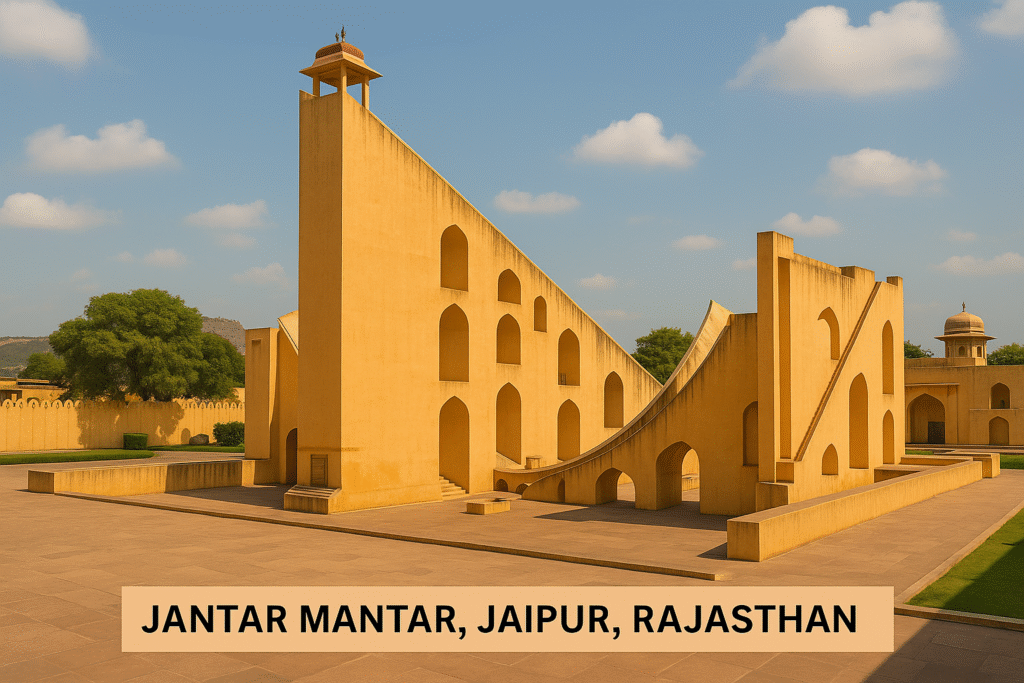
34. Jantar Mantar, Jaipur, Rajasthan
The Jantar Mantar in Jaipur, Rajasthan is one of the most fascinating and unique monuments of India, blending science, astronomy, and architectural brilliance. Built by Maharaja Sawai Jai Singh II in 1734, it is a collection of 19 astronomical instruments used to observe celestial phenomena, measure time, and predict eclipses. This UNESCO World Heritage Site is a remarkable testimony to India’s advanced scientific knowledge in the 18th century.
Situated near the City Palace in Jaipur, Jantar Mantar is one of five observatories built by Jai Singh II, with the Jaipur one being the largest and best-preserved. The instruments are massive in size and were designed for naked-eye observations, demonstrating an extraordinary understanding of mathematics and astronomy.
Among its most notable structures is the Samrat Yantra, the world’s largest stone sundial, which can measure time with incredible precision—up to 2 seconds accuracy. Other instruments include the Jai Prakash Yantra, Rama Yantra, and Narivalaya Yantra, each serving specific astronomical purposes like tracking stars, measuring celestial altitudes, and determining the declination of planets.
What makes Jantar Mantar truly exceptional is not just its scientific utility but also its architectural innovation. The instruments are built with stone and marble, and their geometric forms are both functional and aesthetically captivating.
The observatory continues to attract scientists, historians, tourists, and students alike. It also serves as an educational hub for those interested in ancient Indian astronomy.
As a harmonious blend of art, science, and heritage, the Jantar Mantar in Jaipur proudly holds its place among the most significant monuments of India. It is a lasting symbol of India’s contribution to the global scientific community and a tribute to the vision and intellect of its enlightened rulers.
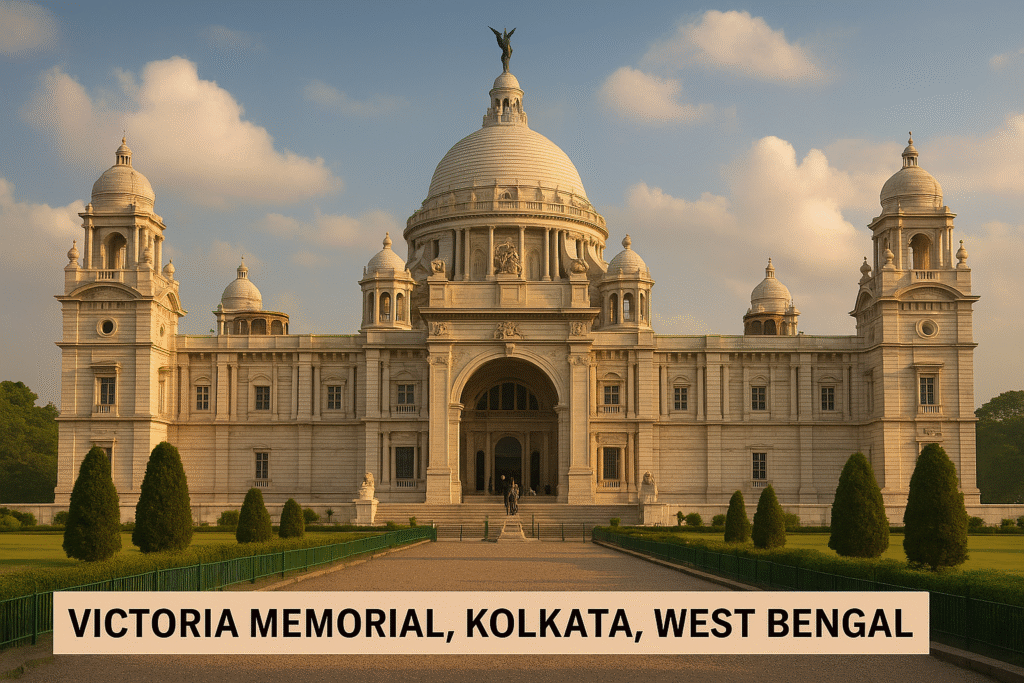
35. Victoria Memorial, Kolkata, West Bengal
The Victoria Memorial, located in the heart of Kolkata, West Bengal, is one of the most iconic colonial-era structures and a prominent entry in the list of historical monuments of India. Built between 1906 and 1921, the memorial was constructed in honor of Queen Victoria, the then Empress of India, following her death in 1901. It stands today as a symbol of the British Raj and a magnificent blend of European and Mughal architecture.
Designed by Sir William Emerson, the Victoria Memorial is made entirely of white Makrana marble and spans over 64 acres of lush gardens. The building is topped with a large dome, crowned by a bronze statue of the Angel of Victory. Inside, the memorial houses a museum featuring 25 galleries with priceless artifacts, British-era paintings, manuscripts, sculptures, and a rich collection of colonial memorabilia.
Among the key highlights of the museum are portraits of Queen Victoria, her personal items, and historical artworks depicting significant events from colonial India. The Royal Gallery, in particular, showcases a visual narrative of British imperial history.
The expansive gardens surrounding the structure, designed by Lord Redesdale and Sir David Prain, offer a peaceful escape for locals and tourists alike. Illuminated beautifully at night, the monument is also a popular venue for cultural events and exhibitions.
Managed by the Ministry of Culture, the Victoria Memorial not only serves as a repository of India’s colonial past but also stands as an architectural marvel. It is a reminder of the historical transitions India has undergone and continues to be a key attraction for history enthusiasts and art lovers.
As one of the most visited monuments of India, the Victoria Memorial remains a symbol of Kolkata’s grandeur and India’s complex historical legacy.
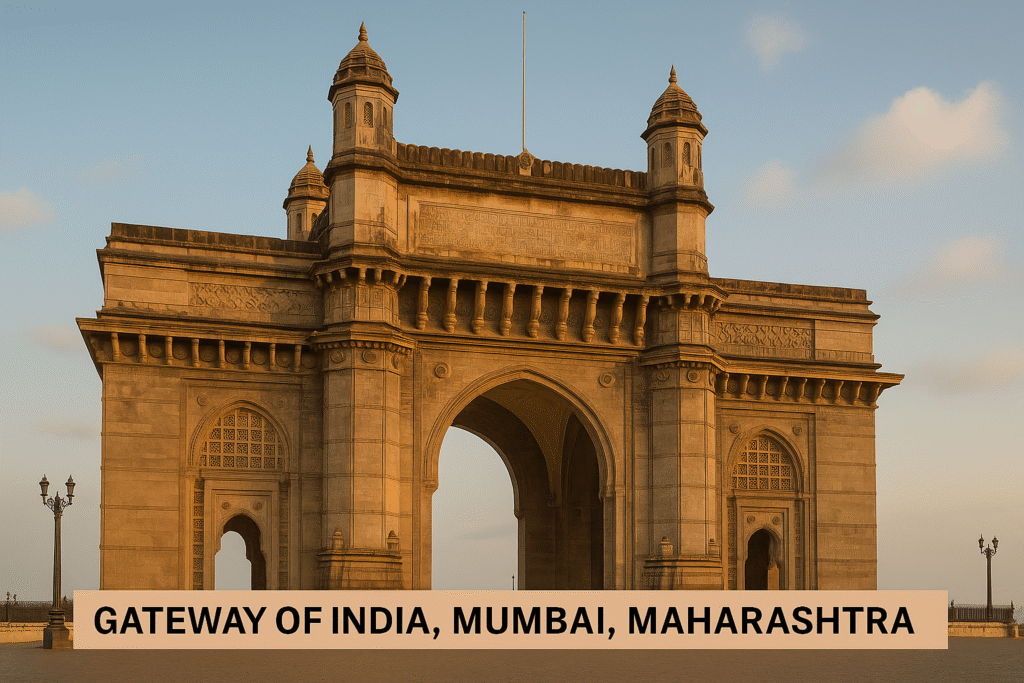
36. Gateway of India, Mumbai, Maharashtra
The Gateway of India, located on the waterfront of Apollo Bunder in Mumbai, Maharashtra, is one of the most recognized and historically significant monuments of India. Constructed during the British colonial era, it stands as a majestic symbol of imperial grandeur and is often referred to as the “Taj of Mumbai” due to its iconic presence near the Arabian Sea.
The foundation stone was laid on 31st March 1913, and the construction was completed in 1924. Designed by George Wittet, the monument combines Indo-Saracenic architectural style with influences of Islamic and Hindu designs. Built using yellow basalt and reinforced concrete, the Gateway stands 26 meters high and features intricate latticework and decorative arches.
Originally erected to commemorate the visit of King George V and Queen Mary to India in 1911, the Gateway also played a significant role in history. In 1948, the last British troops ceremoniously exited India through this arch, symbolizing the end of British rule—a poignant moment in India’s independence story.
The Gateway of India faces the Arabian Sea, making it a scenic attraction for locals and tourists. It serves as the starting point for boat rides to Elephanta Caves, another UNESCO-listed heritage site. Just across from it stands the iconic Taj Mahal Palace Hotel, enhancing the cultural and visual appeal of the area.
Today, the Gateway of India is more than a colonial monument; it is a gathering place, a tourist hub, and a backdrop to numerous cultural events and festivals. Illuminated beautifully at night, it continues to be a proud symbol of Mumbai’s spirit and India’s rich historical legacy.
Among the celebrated monuments of India, the Gateway of India stands tall as a reminder of both colonial history and the resilience of a free nation.
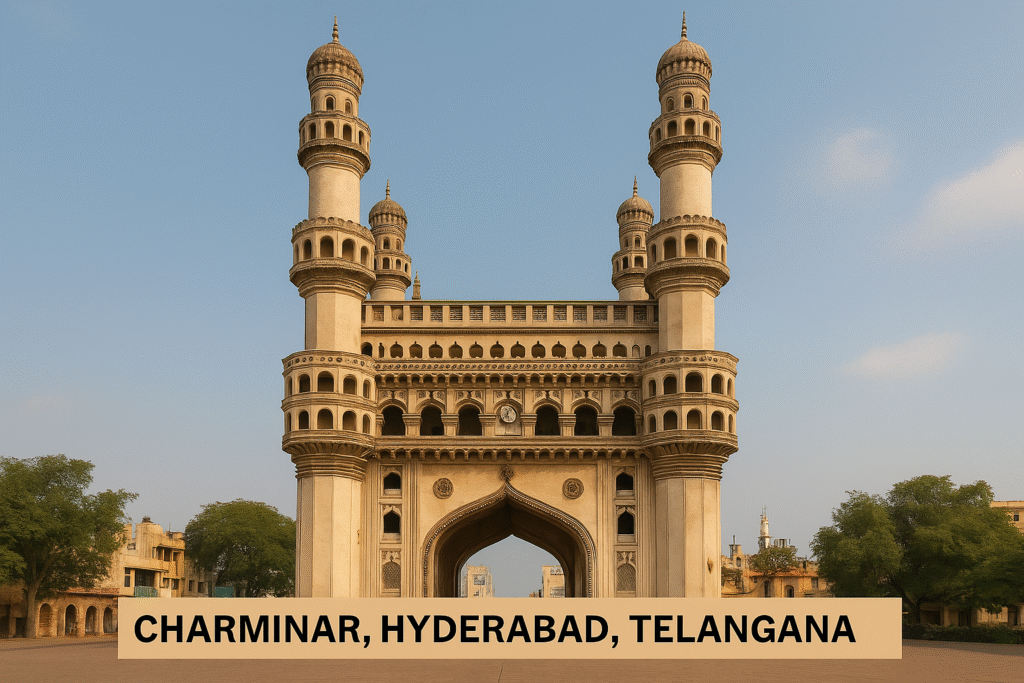
37. Charminar, Hyderabad, Telangana
The Charminar, located in the heart of Hyderabad, Telangana, is one of the most iconic and enduring monuments of India. Built in 1591 by Muhammad Quli Qutb Shah, the fifth ruler of the Qutb Shahi dynasty, the Charminar stands as a symbol of Hyderabad’s rich cultural heritage and architectural brilliance.
The word “Charminar” translates to “Four Minarets,” and the structure is aptly named for its four towering minarets, each rising to a height of about 56 meters. The monument was constructed to commemorate the founding of Hyderabad and is believed to mark the end of a deadly plague that once ravaged the region.
Architecturally, the Charminar is a fine example of Indo-Islamic architecture with influences from Persian design. Built from granite, limestone, mortar, and pulverized marble, the monument features intricate stucco work, floral motifs, and detailed carvings. Its square-shaped structure consists of four grand arches that face cardinal directions, forming gateways to the bustling streets of the Old City.
The Charminar also houses a small mosque on its top floor, which remains an active place of worship. Visitors can climb a narrow staircase within one of the minarets to enjoy a panoramic view of the vibrant Laad Bazaar and surrounding areas.
Surrounded by markets, heritage buildings, and street food vendors, the Charminar is not only a historical monument but also a lively cultural hub. It has become synonymous with the city of Hyderabad, featured in postcards, travel guides, and Bollywood films.
As one of the most beloved monuments of India, the Charminar represents a glorious chapter in the country’s architectural and historical narrative. It remains a symbol of Hyderabad’s enduring spirit and a must-visit destination for anyone exploring India’s timeless landmarks.
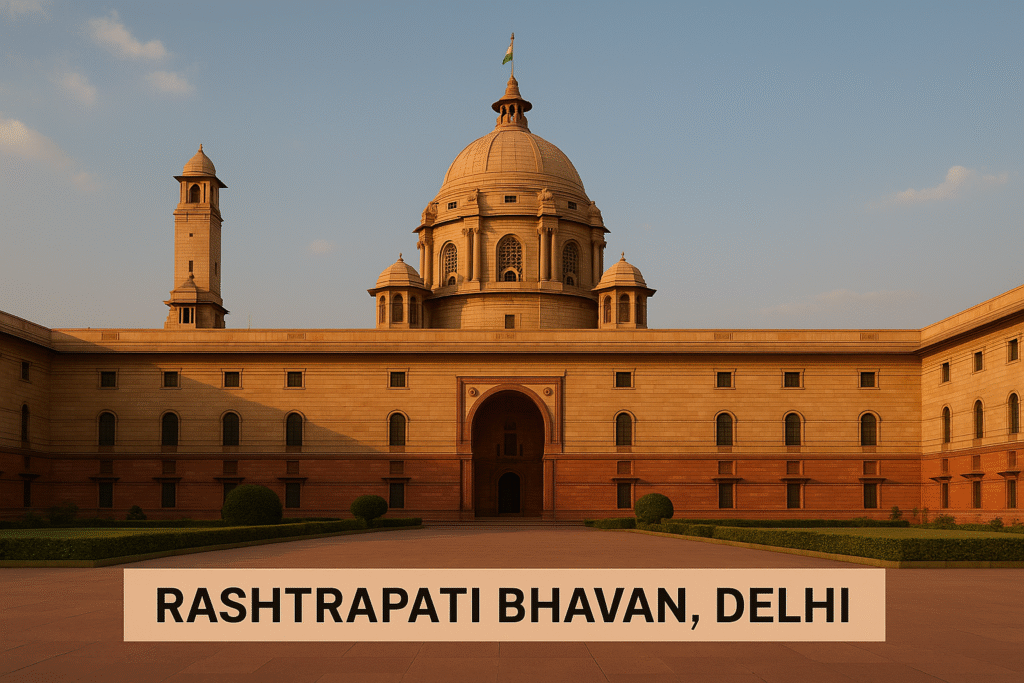
38. Rashtrapati Bhavan, Delhi
The Rashtrapati Bhavan, located at the western end of Rajpath in New Delhi, is one of the most magnificent and prestigious monuments of India. Serving as the official residence of the President of India, this grand architectural masterpiece symbolizes the strength, democracy, and dignity of the nation.
Constructed between 1912 and 1929, Rashtrapati Bhavan was originally designed by British architect Sir Edwin Lutyens as the Viceroy’s House during the British colonial period. After India’s independence in 1947, it became the official residence of the President and was renamed Rashtrapati Bhavan, which means “President’s House.”
Spread over 330 acres, the estate includes the main building with 340 rooms, vast ceremonial halls, presidential offices, guest suites, and staff quarters. The architectural style is a fine blend of Western classical and Indian elements, featuring Dome-shaped pavilions, Mughal gardens, sandstone jalis, and intricate carvings that reflect India’s cultural richness.
The Mughal Gardens, now renamed Amrit Udyan, located at the rear of the building, are an attraction in themselves. Open to the public during spring, these gardens boast a wide variety of flowers, fountains, and neatly manicured lawns, drawing thousands of visitors every year.
Inside Rashtrapati Bhavan are grand halls such as the Ashoka Hall and Durbar Hall, where state ceremonies, official functions, and presidential addresses are held. The entire complex is maintained with the utmost care and stands as a testament to the country’s governance and historical legacy.
As a fusion of power, beauty, and architectural grandeur, the Rashtrapati Bhavan stands tall among the most distinguished monuments of India. It is not only a symbol of the Indian Republic but also a living monument that showcases the country’s journey from colonialism to sovereignty.
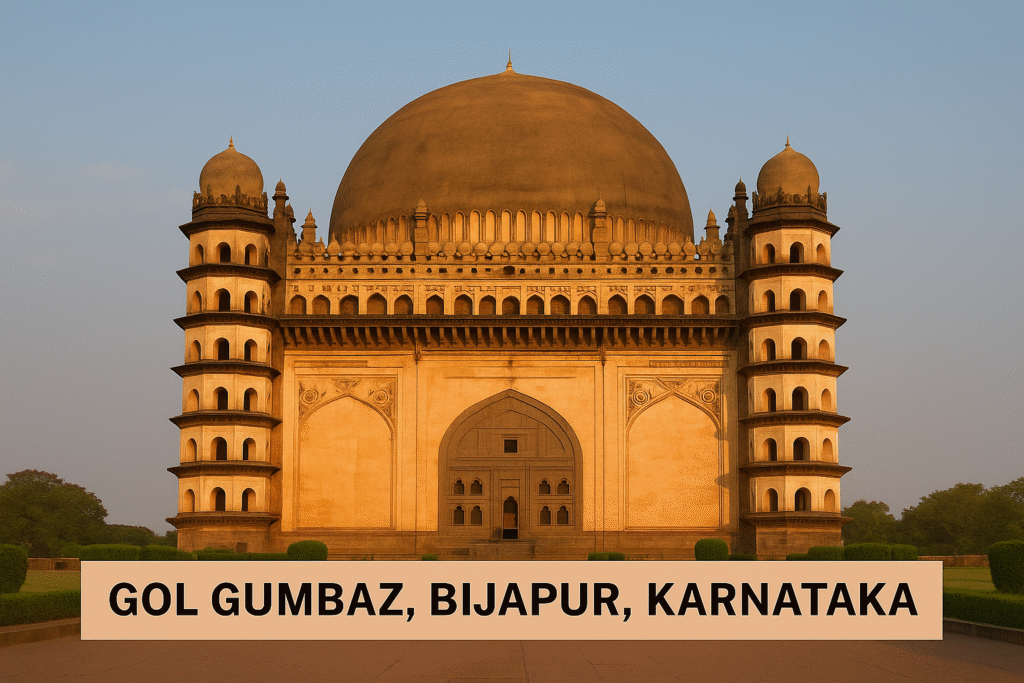
39. Gol Gumbaz, Bijapur, Karnataka
The Gol Gumbaz, located in Bijapur (now Vijayapura), Karnataka, is one of the grandest and most awe-inspiring monuments of India. Built in 1656, it is the mausoleum of Muhammad Adil Shah, the Sultan of Bijapur, and stands as a testament to the architectural brilliance of the Deccan Sultanate period.
The name “Gol Gumbaz” is derived from “Gola Gummata,” meaning “circular dome.” True to its name, the monument is famous for its massive hemispherical dome, which is one of the largest unsupported domes in the world. With a diameter of 44 meters, the dome rests on a cube-shaped structure and rises to a height of 51 meters. Its size and design continue to amaze architects and historians to this day.
One of the most fascinating features of the Gol Gumbaz is the “Whispering Gallery”. Even the slightest sound made inside this circular gallery travels clearly across to the other side due to the incredible acoustics—a feature that draws both curious tourists and science enthusiasts alike.
The structure is built using dark grey basalt and is surrounded by lush gardens. Its design reflects a blend of Indo-Islamic architecture, marked by domes, minarets, and arched entrances. The tomb chamber houses the cenotaphs of Muhammad Adil Shah and his family members.
Gol Gumbaz is managed by the Archaeological Survey of India and remains a major tourist attraction. It stands not only as a symbol of Bijapur’s historic glory but also as a marvel of medieval engineering.
Among the celebrated monuments of India, Gol Gumbaz holds a unique place for its monumental scale, acoustic wonders, and historical significance. It remains a proud architectural jewel of Karnataka and a tribute to the artistic vision of the Deccan era.
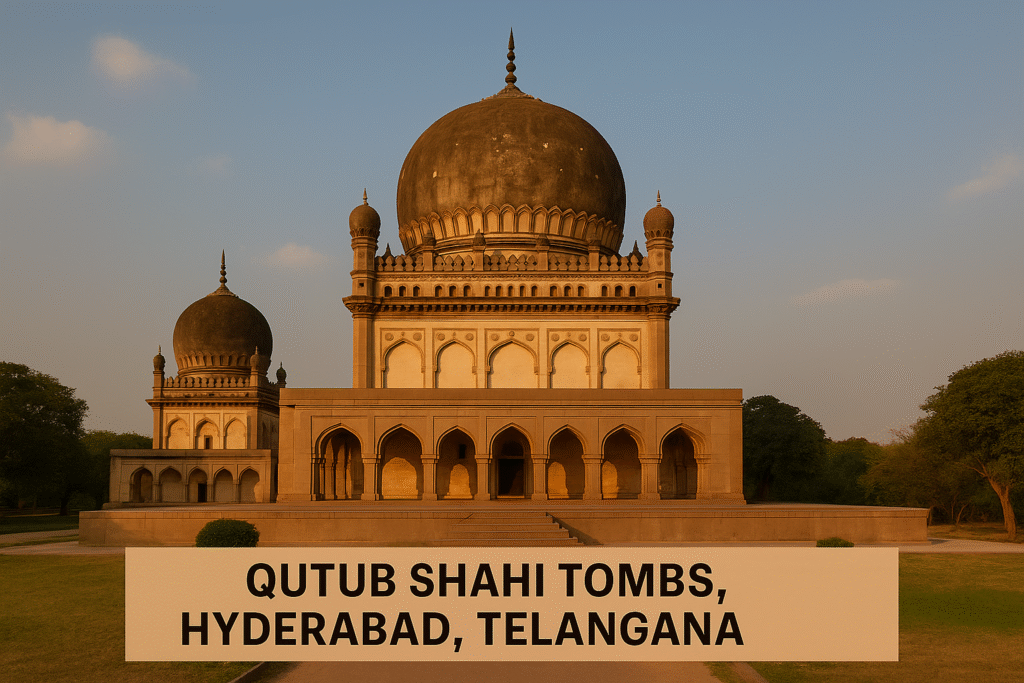
40. Qutub Shahi Tombs, Hyderabad, Telangana
The Qutub Shahi Tombs, located near the famous Golconda Fort in Hyderabad, Telangana, are among the most remarkable historical monuments of India. These tombs serve as the final resting place of the rulers of the Qutub Shahi dynasty, which ruled the Golconda region from the 16th to the 17th century.
Built within the Ibrahim Bagh complex, the Qutub Shahi Tombs include the mausoleums of seven Qutub Shahi kings, along with queens, courtiers, and other royal family members. These tombs are unique in that they represent a blend of Persian, Pathan, and Hindu architectural styles, reflecting the cultural syncretism of the era.
Each tomb is built on a raised platform and crowned with grand domes. They are constructed primarily using grey granite and are adorned with intricate stucco work, delicate carvings, and ornamental arches. The largest and most impressive tomb is that of Sultan Mohammed Quli Qutub Shah, the founder of Hyderabad and the builder of the Charminar.
Set amid lush gardens and peaceful pathways, the site offers a tranquil experience that contrasts with the hustle and bustle of the city. The tombs are being restored under the supervision of the Aga Khan Trust for Culture and the Archaeological Survey of India, aiming to preserve their historical integrity and architectural splendor.
The Qutub Shahi Tombs are not only significant for their historical and architectural value but also for the role they play in showcasing Hyderabad’s regal past. As one of the earliest examples of royal necropolises in India, the complex stands as a solemn and majestic reminder of the city’s glorious heritage.
Among the revered monuments of India, the Qutub Shahi Tombs remain a treasured site that captures the artistic grandeur and royal legacy of the Deccan Sultanate.
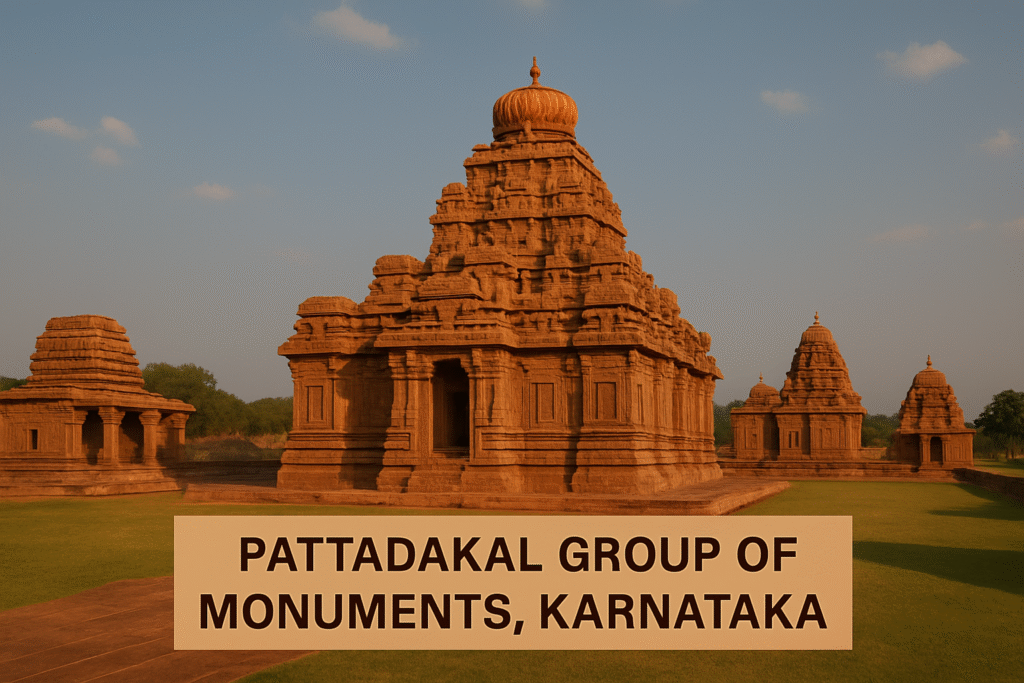
41. Pattadakal Group of Monuments, Karnataka
The Pattadakal Group of Monuments, located in Bagalkot district of Karnataka, is one of the most celebrated monuments of India and a UNESCO World Heritage Site. This ancient complex represents the pinnacle of early Chalukyan architecture and showcases a harmonious blend of Dravidian (South Indian) and Nagara (North Indian) temple styles.
Dating back to the 7th and 8th centuries, Pattadakal served as the royal coronation site of the Chalukya kings, and its name literally means “place of coronation.” The complex houses ten major temples, each dedicated primarily to Lord Shiva, and one Jain sanctuary. These temples are built using red sandstone and are admired for their intricate carvings, sculptural art, and architectural innovations.
Among the most notable temples are:
Virupaksha Temple: Built by Queen Lokamahadevi in 740 CE to commemorate her husband’s victory over the Pallavas, it is the most ornate and well-preserved structure in the complex.
Mallikarjuna Temple: Commissioned by another Chalukyan queen, it mirrors the design of Virupaksha but on a smaller scale.
Kashi Vishwanatha and Papanatha Temples: These structures reflect a perfect fusion of North and South Indian styles.
Jain Narayana Temple: An example of the religious tolerance and diversity during the Chalukyan reign.
The temples at Pattadakal are adorned with beautifully detailed sculptures depicting stories from the Ramayana, Mahabharata, and Puranas, showcasing the cultural richness and artistic mastery of the time.
Today, the Pattadakal Group of Monuments stands as a testament to India’s architectural evolution and religious pluralism. As a crown jewel among the monuments of India, Pattadakal continues to draw historians, architects, and travelers from around the world, offering a glimpse into the grandeur of early medieval India.
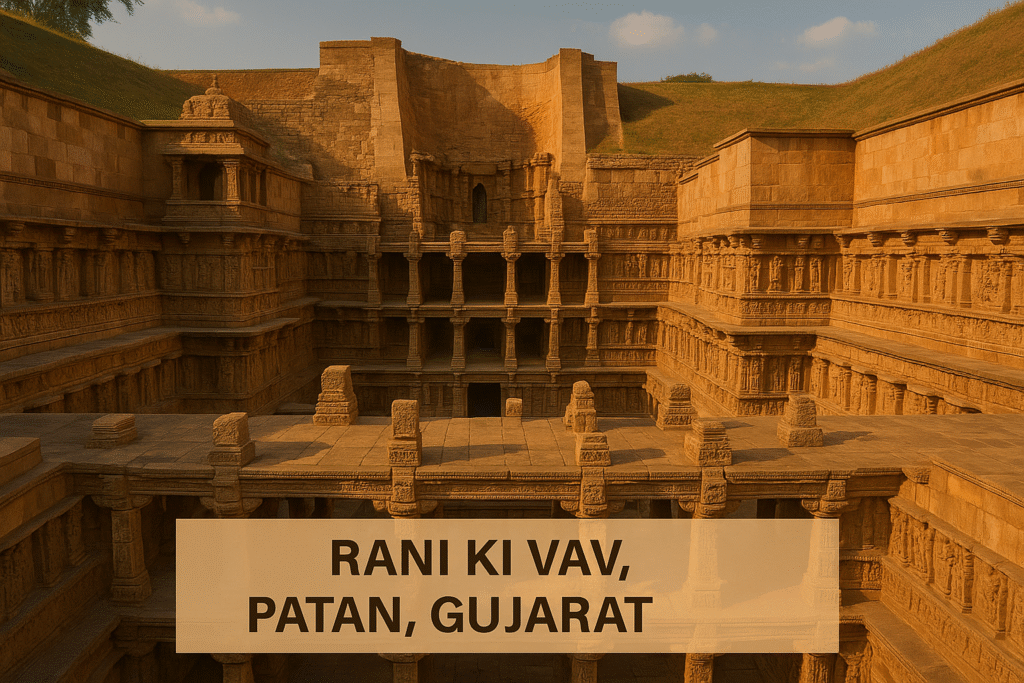
42. Rani ki Vav, Patan, Gujarat
Rani ki Vav, or the Queen’s Stepwell, located in Patan, Gujarat, is one of the most exquisite and architecturally sophisticated monuments of India. Recognized as a UNESCO World Heritage Site in 2014, this subterranean structure is not only a marvel of water architecture but also a symbolic tribute to Indian craftsmanship and devotion.
Built in the 11th century AD by Queen Udayamati, in memory of her husband King Bhimdev I of the Solanki dynasty, Rani ki Vav exemplifies the intricate engineering and aesthetic excellence of ancient Indian artisans. The stepwell was constructed on the banks of the now-extinct Saraswati River to serve both spiritual and practical purposes—providing water and a place for social gatherings and rituals.
This stepwell is over 64 meters long, 20 meters wide, and 27 meters deep, and descends through seven levels of ornate staircases. The walls and pillars are adorned with more than 1,500 intricately carved sculptures, primarily of Lord Vishnu in various avatars like Dashavatara, and mythological scenes from Hindu epics. The symmetry, precision, and artistic detailing reflect the zenith of Solanki-era architecture.
An extraordinary feature of Rani ki Vav is its perfect integration of utility and art. Unlike many other stepwells, it is designed in the form of an inverted temple, emphasizing the sanctity of water.
Buried under silt for centuries and rediscovered and restored by the Archaeological Survey of India, it now stands as a shining example of India’s cultural and architectural legacy.
Among the finest monuments of India, Rani ki Vav continues to mesmerize visitors with its grandeur, storytelling carvings, and deep historical roots, serving as a proud emblem of Gujarat’s ancient heritage.

43. Chhatrapati Shivaji Maharaj Terminus (formerly Victoria Terminus), Mumbai, Maharashtra
The Chhatrapati Shivaji Maharaj Terminus (CSMT), formerly known as Victoria Terminus, is one of the most remarkable architectural and functional landmarks among the monuments of India. Located in the heart of Mumbai, Maharashtra, it serves as both a historic railway terminus and a UNESCO World Heritage Site, recognized for its outstanding Victorian Gothic Revival architecture fused with traditional Indian influences.
Commissioned in 1878 and completed in 1887 to commemorate the Golden Jubilee of Queen Victoria, the terminus was designed by British architect Frederick William Stevens. It took nearly a decade to complete and became the headquarters of the Great Indian Peninsula Railway. The structure was renamed Chhatrapati Shivaji Terminus in 1996, and later updated to Chhatrapati Shivaji Maharaj Terminus to honor the revered Maratha king.
The building’s façade is an intricate blend of Italian Gothic, Mughal, and traditional Indian architecture, featuring pointed arches, turrets, stone domes, and stained glass windows. The impressive central dome is topped with a statue symbolizing Progress, while the interior showcases grand staircases, high vaulted ceilings, and rich woodwork.
CSMT remains one of the busiest railway stations in India, handling millions of commuters daily. Despite its function as a major transport hub, it has retained its architectural grandeur and historical significance. The building is also illuminated at night, creating a striking visual spectacle in the Mumbai skyline.
As one of the finest examples of colonial-era architecture, Chhatrapati Shivaji Maharaj Terminus holds a special place among the monuments of India. It stands not only as a gateway to the city of Mumbai but also as a testament to India’s architectural evolution, blending East and West in perfect harmony.

44. Dwarkadhish Temple, Dwarka, Gujarat
The Dwarkadhish Temple, also known as the Jagat Mandir, is one of the most revered monuments of India and a prominent Hindu pilgrimage site. Located in Dwarka, Gujarat, this majestic temple is dedicated to Lord Krishna, who is worshipped here as Dwarkadhish or the “King of Dwarka.” It is a key destination in the Char Dham Yatra and one of the Sapta Puri, the seven most ancient and holy cities in Hinduism.
Believed to have been originally built more than 2,500 years ago by Lord Krishna’s great-grandson Vajranabh, the current temple structure was reconstructed in the 16th century. It showcases intricate Chalukyan architecture, with a five-storied limestone structure supported by 72 intricately carved pillars. The towering shikhara (spire) rises to a height of approximately 78 meters and is adorned with a massive 84-foot flag, changed multiple times daily with ceremonial precision.
The temple’s sanctum houses the idol of Lord Krishna in a black stone form, exuding divine grace. Devotees also pay homage to various other deities within the temple complex, including Subhadra, Balarama, Rukmini, and Radha.
Located at the confluence of the Gomti River and the Arabian Sea, the Dwarkadhish Temple not only holds religious significance but also offers scenic beauty and a spiritual atmosphere. Pilgrims often perform a holy dip in the Gomti Ghat before entering the temple.
Managed by the Dwarka Peeth, one of the four peeths established by Adi Shankaracharya, the temple is an enduring symbol of devotion and tradition.
Among the sacred monuments of India, the Dwarkadhish Temple stands as a timeless tribute to Lord Krishna’s legacy and continues to attract millions of devotees from across the world seeking spiritual solace and divine blessings.
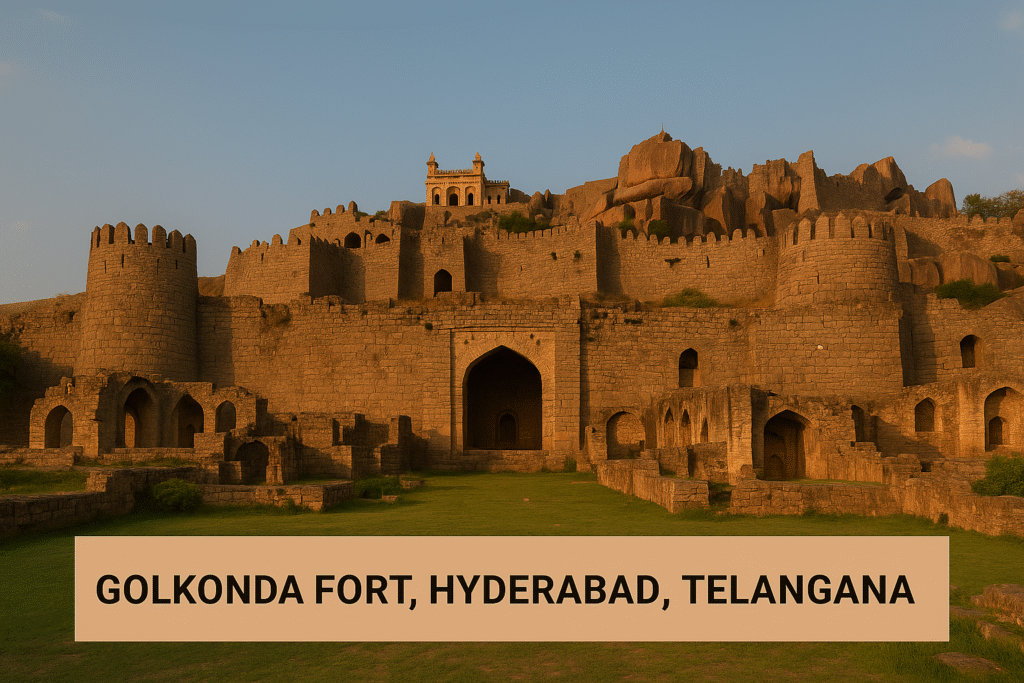
45. Golkonda Fort, Hyderabad, Telangana
The Golkonda Fort, located in Hyderabad, Telangana, is one of the most fascinating and formidable historical monuments of India. Originally a mud fort built by the Kakatiya dynasty in the 12th century, it was later fortified and expanded by the Qutb Shahi dynasty in the 16th century, transforming it into a magnificent citadel of power, art, and architecture.
Spanning across 11 kilometers, the fort complex includes massive battlements, eight imposing gates, four distinct forts, and numerous halls, temples, mosques, and royal apartments. Its strategic location atop a granite hill offers a panoramic view of the surroundings, showcasing its defensive and architectural brilliance.
One of the most intriguing features of Golkonda Fort is its ingenious acoustic system. A hand clap at the entrance gate (Fateh Darwaza) can be heard clearly at the hilltop pavilion, nearly a kilometer away—an engineering marvel designed to alert guards in case of intruders.
The fort is also associated with the world-renowned Koh-i-Noor diamond, which was once stored in its treasure vaults, along with many other priceless gems, highlighting its past as a center of wealth and power.
Architecturally, the fort combines Indo-Islamic styles, with beautifully carved arches, domes, and intricate stucco decorations. The Ramdas Jail, Durbar Hall, and the Rani Mahal reflect the luxurious life of its former rulers.
Today, Golkonda Fort is a major tourist attraction, especially popular for its sound and light show that narrates the fort’s glorious past. It stands as a proud reminder of Hyderabad’s heritage and the architectural genius of ancient India.
Among the many remarkable monuments of India, the Golkonda Fort remains a symbol of strength, grandeur, and historical richness, attracting history buffs and travelers from all over the world.
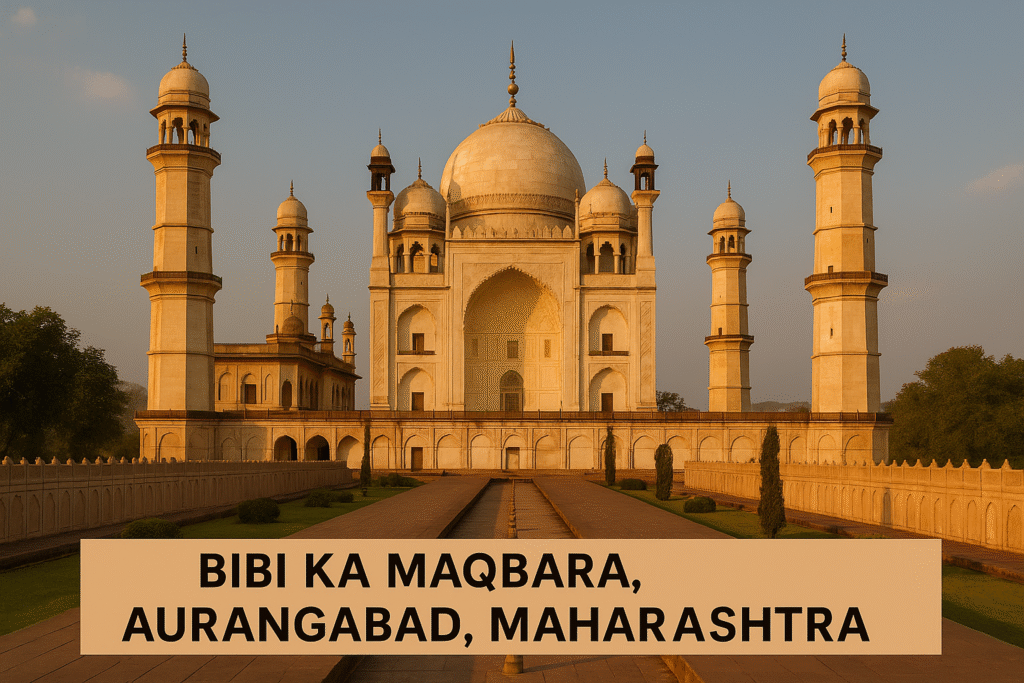
46. Bibi Ka Maqbara, Aurangabad, Maharashtra
Bibi Ka Maqbara, located in Aurangabad, Maharashtra, is a stunning 17th-century mausoleum and one of the lesser-known yet magnificent monuments of India. Often referred to as the “Taj of the Deccan,” it bears a striking resemblance to the iconic Taj Mahal and was built by Azam Shah, son of Mughal Emperor Aurangzeb, in memory of his mother Dilras Banu Begum.
Constructed between 1651 and 1661, Bibi Ka Maqbara was intended to rival the Taj Mahal in grandeur, though it was built with a more modest budget. Despite the financial constraints, the monument exudes elegance and beauty, making it a significant example of Mughal architecture in the Deccan region.
The mausoleum stands in the center of a well-laid Charbagh garden, enclosed by high walls with four towering minarets at the corners. The structure features a large dome made of marble, while the rest of the building is constructed using basalt and covered with a fine layer of lime plaster to resemble white marble. The decorative motifs, arched doorways, lattice screens (jalis), and floral designs reflect the classic Mughal style.
Inside, the tomb of Dilras Banu Begum rests in an octagonal chamber below ground level, visible through delicate marble latticework. The serene ambiance and symmetrical layout of the complex attract numerous visitors, historians, and architecture enthusiasts.
Though it may not match the scale of the Taj Mahal, Bibi Ka Maqbara stands proudly as a tribute to maternal love and Mughal artistry. As one of the prominent monuments of India, it offers a glimpse into the architectural elegance and historical depth of the Mughal era in the Deccan.

47. Tawang Monastery, Tawang, Arunachal Pradesh
The Tawang Monastery, perched at an altitude of over 10,000 feet in the town of Tawang, Arunachal Pradesh, is one of the most revered monuments of India and the largest monastery in India. It is the second-largest in the world after the Potala Palace in Lhasa, Tibet, and holds immense spiritual, cultural, and historical importance for Buddhists, especially those following the Mahayana sect.
Founded in 1680-81 by Merak Lama Lodre Gyatso under the guidance of the 5th Dalai Lama, the monastery is a beacon of Tibetan-Buddhist heritage in India’s northeastern Himalayas. Locally known as Galden Namgey Lhatse, which means “celestial paradise in a clear night,” the monastery sits majestically on a hilltop, offering breathtaking views of the Tawang-Chu valley.
Sprawling across 135 square meters, the monastery complex is fortified with strong walls and houses 65 residential quarters for monks, a library, a museum, and various temples. At the heart of the monastery is the Dukhang (assembly hall), richly decorated with murals and thangkas (Buddhist scroll paintings). The main attraction is a stunning 8-meter-high golden statue of Lord Buddha, which radiates serenity and spiritual power.
Tawang Monastery serves as a center for religious training, Buddhist rituals, and cultural preservation. Its library is a treasure trove of ancient scriptures, including the revered Kangyur and Tengyur texts.
This sacred site plays a vital role in the spiritual life of the Monpa people and other Himalayan communities. It also attracts pilgrims, researchers, and tourists from around the world.
As one of the most remote yet magnificent monuments of India, Tawang Monastery not only embodies the essence of Buddhist philosophy but also reflects India’s diverse spiritual and architectural heritage. It remains a symbol of peace, faith, and Himalayan grandeur.
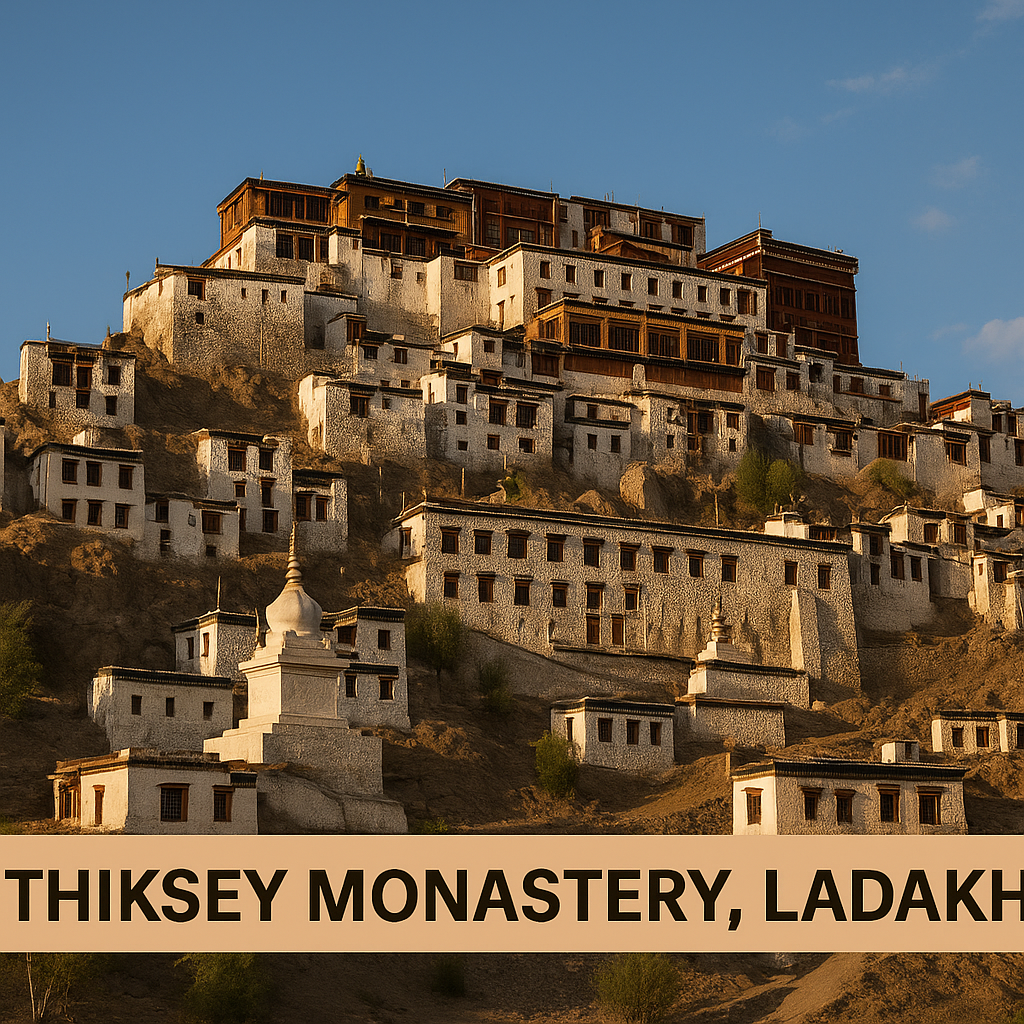
48. Thiksey Monastery, Ladakh
Thiksey Monastery, located in Ladakh’s Indus Valley, is one of the most iconic and visually striking monasteries in India. Situated about 19 kilometers east of Leh, it is a 12-story complex that sits atop a hill, offering panoramic views of the valley below. Belonging to the Gelugpa (Yellow Hat) sect of Tibetan Buddhism, Thiksey Monastery is often compared to the Potala Palace in Lhasa, Tibet, due to its architectural grandeur and hilltop location.
Founded in the 15th century by Palden Zangpo, a disciple of Tsongkhapa, the monastery is an important center of Buddhist learning and spiritual practice. It houses a large number of monks, as well as sacred scriptures, thangkas (religious paintings), stupas, and statues. One of its most impressive features is the 15-meter-high statue of Maitreya Buddha (the future Buddha), which was installed to commemorate the visit of the 14th Dalai Lama in 1970. This two-story statue is a major attraction and a symbol of peace and compassion.
Thiksey Monastery also has a beautiful assembly hall (du-khang), prayer halls, and a rich collection of Buddhist artifacts. The annual Gustor Festival, celebrated here with sacred mask dances and rituals, draws many visitors and pilgrims. The monastery’s peaceful surroundings, combined with its spiritual aura, make it a must-visit destination in Ladakh.
As one of the most visited monuments in Ladakh and a symbol of Tibetan Buddhist heritage in India, Thiksey Monastery stands as a testament to the region’s cultural and religious richness. It not only offers spiritual solace but also serves as a reminder of India’s diverse and vibrant history.
49. Shantiniketan, West Bengal
Shantiniketan, located in the Birbhum district of West Bengal, is a unique cultural and educational landmark that holds a special place among the monuments of India. Founded by Maharshi Debendranath Tagore and later expanded by his son, the Nobel Laureate Rabindranath Tagore, Shantiniketan is more than just a town—it is a symbol of India’s artistic, literary, and educational heritage.
Rabindranath Tagore established Visva-Bharati University at Shantiniketan in 1921, envisioning it as a center of learning that blended the best of Eastern and Western philosophies. The university emphasizes open-air classes, artistic expression, and holistic education. Over the years, it has attracted scholars, artists, and students from around the world and continues to be a beacon of cultural and intellectual activity.
The campus itself is dotted with numerous monuments and buildings of historical and architectural significance. Some notable structures include the Uttarayan Complex, where Tagore lived and worked; Kala Bhavana, the center for visual arts; and Sangeet Bhavana, dedicated to music and performing arts. These buildings are adorned with murals, sculptures, and artworks by renowned artists such as Nandalal Bose, Ramkinkar Baij, and Binod Behari Mukherjee.
Shantiniketan is also known for festivals like Poush Mela and Basanta Utsav, which celebrate Bengali culture, music, and traditions. These events draw thousands of visitors and create a vibrant cultural atmosphere.
Recognized by UNESCO as a World Heritage Site, Shantiniketan stands as a living monument to Rabindranath Tagore’s vision of harmony, creativity, and education. It is not only a place of historical importance but also a continuing inspiration for those who believe in the transformative power of culture and learning.
50. Basilica of Bom Jesus, Old Goa, Goa
The Basilica of Bom Jesus, located in Old Goa, is one of the most revered and historically significant Christian monuments in India. A UNESCO World Heritage Site, it is renowned for housing the mortal remains of St. Francis Xavier, a Spanish missionary who played a crucial role in the spread of Christianity in Asia during the 16th century.
Built in 1605, the Basilica is an exceptional example of Baroque architecture in India. Its name, “Bom Jesus,” means “Good Jesus” in Portuguese, reflecting Goa’s colonial past. The church’s exterior is constructed from laterite stone and, though simple in appearance, it has withstood the test of time. In contrast, the richly ornamented interior features intricate woodwork, gilded altars, and marble mosaics that reflect European artistic styles fused with Indian craftsmanship.
The main altar is dedicated to Infant Jesus, while the highlight remains the silver casket containing the sacred relics of St. Francis Xavier. These remains are displayed to the public every ten years during a special exposition, drawing thousands of pilgrims and tourists from across the globe.
The Basilica is not just a religious site but also a cultural and architectural treasure. It marks the beginning of Christian missionary activity in India and is a symbol of the cultural exchange between Europe and Asia during the colonial era. It continues to function as a place of worship and attracts visitors interested in history, art, and spirituality.
As one of the oldest churches in India and a landmark of Old Goa’s heritage, the Basilica of Bom Jesus stands as a powerful reminder of Goa’s colonial legacy and the rich tapestry of religious and architectural diversity that defines India.
